PSM and Agile Transformation: Empowering Organizations to Embrace Agile Methodologies

Agile transformation is a multifaceted journey towards the widespread adoption of Agile principles and practices within an organization. It’s a formidable undertaking, but the potential benefits are substantial. Professional Scrum Masters (PSMs) can be instrumental in facilitating this transformation. Here’s how PSMs can assist organizations in their Agile evolution: Incorporating these strategies, PSMs can assume a pivotal role in facilitating the successful adoption and implementation of Agile practices. In addition, here are some key recommendations for PSMs supporting Agile transformation: PSMs are uniquely positioned to facilitate organizations in their Agile endeavors. By following these suggestions, PSMs can become valuable assets in steering organizations towards success in Agile transformation.
CSPO vs PSPO: Exploring the Differences

In the world of agile project management, two certifications stand out for people responsible for products: Certified Scrum Product Owner (CSPO) and Professional Scrum Product Owner (PSPO). They both focus on the product owner’s job, but they have distinct features, like where they come from, how you get them, and what they emphasize. This blog will help you understand these differences and figure out which one suits you better. Roles Clarified Before we delve into CSPO and PSPO differences, let’s make sure we know what these roles are about. CSPO (Certified Scrum Product Owner): PSPO (Professional Scrum Product Owner): Main Differences Picking the Right Certification Choosing between CSPO and PSPO comes down to what you want and need. Choose CSPO if: Choose PSPO if: In the end, both CSPO and PSPO can boost your skills as a product owner and give you insights into Scrum and agile practices. The choice should reflect your preferences, your organization’s requirements, and how you learn best. The real key to success in your product owner role is applying what you learn to deliver value to customers and stakeholders.
How Much Money Can You Make as a Scrum Master?

The job of a Scrum Master has become important in the tech world. Scrum Masters help teams work better using agile methods. Many people want to know how much money they can make in this role. In this blog, we’ll talk about Scrum Master salaries and what affects them. Understanding the Scrum Master Job Before we dive into Scrum Master salaries, let’s see what they do. Scrum Masters aren’t like traditional bosses. They help teams work well by: 1. Fixing Problems: They help teams when they have issues or can’t make progress. 2. Teaching: They show team members how to work better using agile methods. 3. Leading Meetings: They run important meetings for teams. 4. Protecting Teams: They keep distractions away from teams so they can focus on their work. Now that we know the basics, let’s learn how much money Scrum Masters can make. Factors That Affect Scrum Master Salaries 1. Experience: Like most jobs, the longer you work, the more you can earn. People who are new to this role make less money than those with more experience. 2. Where You Work: Your salary depends on where you live. In places like Silicon Valley or New York City, where it’s expensive to live, Scrum Masters usually make more money. 3. Certifications: Getting special certificates like Certified ScrumMaster (CSM) or Certified Scrum Professional (CSP) can help you make more money. These certificates show you’re good at your job. 4. Company Size: Big companies usually pay more than small ones. They also offer better benefits. 5. Type of Company: Different types of companies pay differently. For example, healthcare or finance companies may pay more than non-profit organizations. 6. Education: While you don’t need a special degree, having one can help you earn more. The Average Scrum Master Salary On average, Scrum Masters in the United States make between $80,000 and $130,000 per year. But remember, this can change a lot based on where you are and your experience. Let’s look at the salary range in more detail: 1. New Scrum Masters: If you’re new to the job, you might make between $60,000 and $90,000 per year. 2. Mid-Level Scrum Masters: Those with 2-5 years of experience usually earn between $80,000 and $120,000 annually. 3. Experienced Scrum Masters: If you have more than 5 years of experience and a good track record, you might make over $130,000 a year. These are just averages, so your salary might be different. Tips to Make More Money as a Scrum Master 1. Keep Learning: Stay updated on agile and Scrum. Attend workshops and get more certifications to show you’re really good at your job. 2. Meet People: Build a network in the tech industry. It can help you find better jobs with higher pay. 3. Ask for More Money: Don’t be shy about talking about your salary. When you get a new job or have a review, ask for the pay you deserve. 4. Get More Certifications: Consider getting advanced certifications like Certified Scrum Professional or Agile Coach. They can lead to higher-paying jobs. 5. Be Willing to Move: If you can, think about moving to places where Scrum Masters are needed. You might find better-paying jobs there. 6. Find a Mentor: Look for someone who can teach you about being a Scrum Master. Learning from experienced people can help you make more money. Conclusion Being a Scrum Master can bring good pay, but it’s also about helping teams work well. Salaries vary based on where you work and your experience. By learning more, networking, and thinking carefully about your career, you can make more money as a Scrum Master. Remember, success isn’t just about money; it’s about helping teams do their best with agile methods.
The Power of Certified Agile Leadership: Leading in Today’s Changing World

In a world where everything changes quickly, the old ways of leading a team or a company don’t always work. That’s why many organizations are turning to something called “Certified Agile Leadership” or CAL. It’s a way for leaders to learn new skills and ways of thinking that help them succeed in today’s fast-paced world. This blog will explain what CAL is all about and why it’s so important for leaders. Understanding Certified Agile Leadership (CAL) Certified Agile Leadership, or CAL for short, is a program that helps leaders become better at their jobs. But it’s not just about learning new methods; it’s about changing the way you think about leadership. 1. Thinking the Agile Way CAL teaches leaders to think differently. It helps them understand the importance of working together, focusing on customers, and being flexible. These ideas are really important in today’s world. 2. Leading in a New Way In an Agile organization, leadership isn’t just about the boss at the top. It’s about everyone, at all levels, working together. CAL helps leaders become better at letting their teams make decisions and be creative. 3. Dealing with Uncertainty The world is uncertain, and things change fast. CAL helps leaders get good at handling this uncertainty. They learn how to adapt and change their plans when needed. Why Certified Agile Leadership Matters So, why is CAL such a big deal? Here’s why: 1. Making Change Happen CAL helps leaders be good at making changes in their organizations. They learn how to get everyone on board with new ways of working, which is super important. 2. Better Teamwork CAL helps leaders create a work environment where everyone works well together. This teamwork leads to better ideas and better work. 3. Making Good Choices CAL teaches leaders how to make better decisions. It helps them trust their teams to make decisions when they’re the best people to do it. This means quicker and smarter choices. 4. Customers Come First Agile is all about making customers happy. CAL shows leaders how to keep customers in mind in everything they do. Happy customers mean more success. 5. Quick Strategy CAL helps leaders be smart about their big plans. They learn how to break these plans into smaller pieces that can be done quickly and changed as needed. This makes organizations more flexible and competitive. The Impact of Certified Agile Leadership Here’s how CAL makes a difference: 1. Personal Growth CAL helps leaders grow personally. It encourages them to learn more about themselves and get better at their jobs. This is important in a changing world. 2. Better Teams Teams led by CAL-certified leaders work really well. They’re more motivated, work better together, and do a better job. They also handle changes better. 3. Changing Organizations CAL changes organizations for the better. It makes them more flexible, responsive, and customer-focused. This means they can do things faster, better, and make their customers happier. 4. Being Creative and Adaptable CAL helps organizations be more creative and adaptable. It encourages them to try new things, learn from their mistakes, and stay ahead of the competition. Becoming a CAL-Certified Leader If you want to become a CAL-certified leader, here’s how: 1. Learn About Agile: Start by learning what Agile is all about. You can find training courses and resources to help you understand it better. 2. Try It Out: Experiment with Agile ideas in your own work. See how they work in practice. 3. Get Help: Find someone experienced in Agile to mentor or coach you. Learning from others is a great way to get better. 4. Keep Learning: Remember that Agile is about always improving. Stay curious and open to new ideas. 5. Get Certified: Consider getting a Certified Agile Leadership certification. This shows others that you’re really good at Agile leadership. Conclusion Certified Agile Leadership is a powerful way for leaders to succeed in today’s fast-paced world. It helps them think differently, lead better, and make their organizations more flexible and customer-focused. CAL-certified leaders are at the forefront of change and innovation. In a world where everything changes quickly, embracing Certified Agile Leadership is a smart move for leaders who want to lead effectively and make their organizations successful.
How to enhance Agile Team Success

In our fast-changing business world, organizations are turning to Agile methods to stay nimble and deliver results quickly. But adopting Agile isn’t a guarantee of success. To truly make Agile work, teams need to do more. In this blog, we’ll explore some easy-to-understand ways to help Agile teams succeed. 1.Keep Growing Think of challenges as chances to learn and get better. When you make mistakes, don’t worry – use them to improve. 2.Know Where You’re Going Understand what your team is trying to do and why it’s important. When everyone knows the goal, it’s easier to work together. 3.Work Together Agile teams are like puzzle pieces that fit together. Everyone brings their skills to the table. Working together brings new ideas and makes problems easier to solve. 4.Focus on the Customer Make sure what you do helps the people you’re making things for. Listen to what they say and change your work to match their needs. 5.Keep Your To-Do List Organized Keep track of what needs to be done, and make sure the most important stuff gets done first. 6.Look Back and Improve Take time to think about what you did and how you could do it better. Learning from the past helps you get better in the future. 7.Be Ready for Change Plans can change fast. Be ready to switch gears when you need to. This helps you stay on the right track. 8.Keep Learning Keep training and learning new things. The more you know, the better you can do your job. 9.Be in Control Give team members the power to make decisions about their work.This instills a sense of accountability in them for their actions. 10.Talk, Talk, Talk Keep talking to your team and anyone else involved in your work. This helps everyone know what’s happening. 11.See How You’re Doing Use charts and boards to show how you’re doing. This makes it easier to see if there are any problems. 12.Don’t Forget Quality Make sure what you make is good. Don’t rush so much that you forget to do things right. 13.Use Tools Use tools and tech to help you work better. It can make things easier and help you see what’s happening. 14.Celebrate Success When you do something great, celebrate it! This makes everyone feel good and helps build a great team. 15.Keep Getting Better Agile is about always getting better. Keep looking for ways to improve your work, little by little. Conclusion Making Agile work isn’t hard if you keep learning, work together, and stay focused on what matters most. Agile is like a journey where you keep getting better, step by step. With these simple strategies, Agile teams can deliver great results and adapt to the fast-paced world of business.
Top Scrum Alliance Certifications That Pay Well in 2023

Introduction In today’s tech-driven world, Scrum has become a leading method for project management, especially in Agile development. This has made Scrum Alliance certifications highly valuable in the job market. In this blog, we’ll explore some Scrum Alliance certifications that can lead to well-paying jobs in 2023. 1. Certified ScrumMaster (CSM) The Certified ScrumMaster (CSM) certification is an excellent starting point for anyone interested in Agile and Scrum. CSMs help teams work together effectively using Scrum practices, remove obstacles, and ensure the team follows Scrum principles. Why CSM pays well: CSMs are in demand because they play a crucial role in Scrum teams. They promote teamwork, solve problems, and keep the team on track, which makes them valuable. On average, CSMs earn around $105,000 per year in 2023. 2. Certified Scrum Product Owner (CSPO) The Certified Scrum Product Owner (CSPO) certification is for professionals responsible for getting the most value from the products Scrum teams create. CSPOs work with stakeholders, prioritize tasks, and make sure the product aligns with the company’s goals. Why CSPO pays well: CSPOs bridge the gap between business and development, making sure products meet customer needs and business objectives. Their ability to make informed decisions and guide product development leads to salaries averaging $110,000 per year in 2023. 3. Advanced Certified ScrumMaster (A-CSM) The Advanced Certified ScrumMaster (A-CSM) certification is for experienced Scrum Masters who want to deepen their skills. A-CSMs focus on coaching, mentoring, and facilitating Scrum at an advanced level. Why A-CSM pays well: A-CSMs are experts in Scrum and Agile practices. They help teams navigate complex challenges and improve continuously, which organizations value. In 2023, A-CSMs earn an average of around $120,000 per year. 4. Certified Scrum Professional (CSP) The Certified Scrum Professional (CSP) certification is for experienced Scrum practitioners who want to showcase their mastery of Scrum principles and practices. CSPs are recognized as leaders in the Agile community and often take on coaching and consulting roles. Why CSP pays well: CSPs bring extensive experience and expertise to organizations. They lead Agile transformations, drive change, and mentor others in Scrum and Agile practices. In 2023, CSPs earn an average of approximately $140,000 per year. 5. Certified Scrum Trainer (CST) The Certified Scrum Trainer (CST) certification is the highest level of certification offered by Scrum Alliance. CSTs are experts in Scrum and Agile practices, authorized to train and certify others. They play a critical role in spreading Scrum knowledge and practices globally. Why CST pays well: CSTs are at the top of the Scrum Alliance certification ladder, and their expertise is in high demand. They travel, train professionals, and influence Scrum adoption in various industries. In 2023, CSTs earn an average of approximately $180,000 per year. Conclusion Scrum Alliance certifications are vital for boosting the earning potential of Agile and Scrum professionals in 2023. Whether you’re starting with a CSM certification or aiming for the top as a CST, these certifications open doors to well-paying opportunities. As more organizations adopt Agile and Scrum, certified professionals who can drive success will be in high demand. So, consider pursuing one or more of these certifications if you want to advance your career and earn more in 2023.
Dependencies in Scrum: How They’re Handled

Scrum is great for agile teamwork, but sometimes tasks or teams depend on each other to get things done. These dependencies can slow things down if not managed well. In this article, we’ll look at what dependencies are in Scrum and how we deal with them to make sure projects succeed. What Are Dependencies in Scrum? Dependencies in Scrum happen when one task or team needs another task or team to finish their work. There are different types: 1.Technical Dependencies: When one task needs something from another task to move forward, like a front-end team needing a back-end team’s work. 2.Sequential Dependencies: Some tasks must be done in a certain order, like designing the user interface before doing front-end work. 3.Resource Dependencies: Limited resources, like experts or special tools, can slow things down because teams have to wait for them. 4.External Dependencies: Sometimes, Scrum teams depend on outside vendors or partners to provide something important. 5.Compliance Dependencies: In projects with rules and regulations, tasks must be done in a certain order to follow the law. Problems with Unmanaged Dependencies If we don’t handle dependencies well, it can cause problems: 1.Delays: Projects can slow down when teams have to wait for others. 2.Less Productivity: Team members might not have enough to do, which can lead to lower morale and productivity. 3.Uncertainty: It’s hard to plan when you’re not sure when things will get done. 4.Quality Issues: Rushing to catch up can lead to mistakes and lower quality work. 5.More Risk: Unmanaged dependencies can make projects riskier and more likely to fail. How to Manage Dependencies in Scrum Scrum gives us ways to manage dependencies and reduce their impact: 1.Spot Dependencies Early: Find dependencies as soon as possible in the project. 2.Draw a Map: Use visuals like dependency maps to show how tasks and teams depend on each other. 3.Plan Together: When you plan what to work on next, talk about and prioritize tasks with dependencies. 4.Talk a Lot: Teams should talk daily and during meetings to discuss dependencies and any issues. 5.Fix Dependencies: Teams need to work together to solve dependencies, like sharing resources or changing priorities. 6.Big Picture Meetings: For larger projects or when many teams are involved, hold regular meetings to discuss dependencies. 7.Define “Done”: Make sure your “Definition of Done” includes fixing dependencies before you consider a task complete. 8.Extra Time: Sometimes, you need extra time in your schedule to deal with unexpected delays from dependencies. 9.Learn and Improve: After each part of the project, think about how dependencies were managed and how you can do better next time. 10.Tools: Consider using project management tools that help you keep track of dependencies. The Scrum Master and Product Owner’s Roles The Scrum Master and Product Owner are key players in managing dependencies: Scrum Master: This person helps the team communicate and work well together. They spot and help solve dependencies and remove obstacles. Product Owner: The Product Owner knows what’s important for the product. They can help the team decide which tasks to do first to handle dependencies better. Conclusion Dependencies happen in Scrum, but you can manage them. By finding, mapping, and solving dependencies through talking and teamwork, Scrum teams can stay flexible and deliver what customers need. Just remember that handling dependencies is an ongoing process that gets better with practice in the world of Scrum.
The Qualities of a Great Scrum Master

In the world of software development, Agile is a popular method for flexibility and efficiency. At the center of Agile, there’s Scrum, a framework that helps teams work together smoothly. Leading a successful Scrum team is an effective Scrum Master. But what makes a Scrum Master really good at their job? In this blog, we’ll explore the key traits and skills that define a top-notch Scrum Master. 1.Putting the Team First A great Scrum Master is like a team’s captain. They prioritize the team’s needs above all else. They help solve problems, make sure everyone talks to each other, and make sure the team has what it needs to do their work well. 2.Understanding People Effective Scrum Masters are good with people. They know how team members feel and what they care about. By being friendly and understanding, they create an environment where people can speak up and share their thoughts. 3.Good at Talking and Writing Talking and writing are super important. A Scrum Master needs to be able to explain how the team is doing, what problems they have, and what they need clearly. They also need to be great listeners to understand what others are saying. 4.Solving Conflicts In the world of software, conflicts can happen. A great Scrum Master doesn’t run away from them but helps the team find solutions when conflicts pop up. 5.Knows Scrum Well A good Scrum Master really gets Scrum. They don’t just follow rules blindly; they understand why Scrum works the way it does. This helps them adapt Scrum to fit their team and company better. 6.Always Looking to Improve Agile is all about getting better all the time. An effective Scrum Master is always looking for ways to make the team better, whether that’s by improving how they work or learning new things. 7.Can Make Decisions In software, you often need to make choices quickly. An effective Scrum Master isn’t afraid to make tough decisions when needed. They balance what the team thinks with what needs to happen fast. 8.Helping the Product Owner Scrum Masters don’t just help the team; they also support the Product Owner. They assist in organizing the product backlog, making sure it’s clear and in the right order. This helps the team know what to work on. 9.Loves Agile Values A great Scrum Master is a big fan of Agile values and principles. They spread the Agile way of thinking in the team and the company. This means making sure everyone is open, keeps an eye on what’s happening, and is willing to change. 10.Stays Strong and Patient Scrum Masters often face tough times. It is important for them to stay strong and be patient, even when things get hard. They stay positive and keep pushing for Agile practices, even when others don’t want to change. 11.Uses Data for Decisions Effective Scrum Masters rely on data to make choices. They gather facts and information to see how well the team is doing and find areas to improve. Using data ensures changes are based on evidence, not just guesses. 12.Knows Some Tech While not a must, having some tech knowledge can help. It helps Scrum Masters understand the team’s challenges better and join technical discussions more easily. Conclusion In the Agile world, a great Scrum Master is like the captain steering a ship through the turbulent waters of software development. They lead by example, are good with people, and spread the Agile way of thinking. They’re excellent at communicating, solving problems, and understand Scrum deeply. With their skills in conflict resolution and a constant drive for improvement, they empower their team to keep delivering value. As more companies adopt Agile methods, the role of the Scrum Master isn’t just important; it’s essential for the success of Agile projects.
WHAT IS A SCRUM TEAM

In the world of software development, where things change fast, Scrum is a great way to manage projects. It’s like a team sport where everyone works together to win. This blog explores the Scrum team, what it does, and why it’s vital for successful projects in the Agile world. 4. Scrum Team’s Special QualitiesIt shine in Agile because they: 5. Important Scrum Team Activitiesit follow specific routines to work well together. These include: 6. How the Scrum Team Boosts Agile SuccessIt is like a superpower because it: 7. ConclusionIn a nutshell, the Scrum team is the beating heart of Agile projects. It’s not just a group of people; it’s the driving force behind innovation, efficiency, and excellence in software development.
Trust and Transparency: The Pillars of a Successful Scrum Team

Introduction In the world of software development, Scrum is like the secret sauce for efficient project management. It’s all about teamwork, adapting on the fly, and building things step by step. But, here’s the catch: for a Scrum team to work its magic, it needs two crucial ingredients – trust and transparency. In this blog, we’ll talk about why these two things are so important for a Scrum team to thrive. Understanding Scrum Before we dive in, let’s quickly go over what Scrum is all about. Scrum is an approach that breaks a big project into smaller parts, or “sprints,” that last a few weeks each. The magic happens when a team works together on these sprints. There are key roles like the Product Owner, Scrum Master, and Development Team. Trust in Scrum 1. Trust in Your Teammates Imagine you’re playing a sport. You need to trust your teammates to pass the ball, make the right moves, and score. In a Scrum team, trust is like that trust in your sports buddies. You have to believe in each other’s skills and intentions. Without it, teamwork becomes tough, and the job takes longer. 2. Trust in the Scrum Way Scrum has its rules and practices, like daily meetings and planning sessions. Trust in these methods is crucial. If someone doubts the way things are done, it slows down the whole team. 3. Trust in the Product Owner The Product Owner decides what features to work on first. The team must trust that they’re making smart choices based on what customers need. 4. Trust in the Scrum Master The Scrum Master’s job is to guide the team and remove obstacles. Trusting their guidance and experience is vital for a smooth journey. Transparency in Scrum 1. Keep Work Transparent Transparency means everyone knows what’s going on. In Scrum, it’s important to be clear about what’s getting done, any roadblocks, and any changes in plans. This way, everyone is on the same page, which helps teamwork. 2. Open Communication Imagine if your teammates in a game didn’t talk to you. Communication is key. In Scrum, you should speak up in meetings, share challenges, and ask for help when needed. Talking openly helps solve problems faster. 3. Clear Backlog The product backlog is a list of tasks. It should be easy for everyone to see and understand what’s on the list. This makes it simpler to plan and do the work. 4. Explain Decisions When decisions are made, everyone should know why. If you’re wondering why something is more important than something else, it should be explained. This helps everyone understand the goals. How Trust and Transparency Work Together Trust and transparency are like best buddies. They support each other: 1. Trust Leads to Transparency When you trust your team and the Scrum process, you’re more likely to share information and ask for help when needed. This leads to better transparency because you’re not holding things back. 2. Transparency Builds Trust When everyone communicates openly and shares information, trust grows. You know you can count on your teammates, and that builds confidence in the team’s abilities. Why Trust and Transparency Matter 1. Better Teamwork When you trust each other and know what’s happening, you work together smoothly. This boosts problem-solving, quick decisions, and top-notch results. 2. Higher Productivity With trust and clear information, you can focus on your tasks without worries. That means more work gets done. 3. Quick Problem Solving Open communication means problems pop up early and get solved fast. No more waiting until they become big headaches. 4. More Innovation A culture of trust and transparency encourages creative thinking. Team members feel safe suggesting new ideas, which leads to better solutions and constant improvement. 5. Happier Work Environment Trust and transparency make work more pleasant. When you feel valued and heard, you enjoy your work more. Conclusion In Scrum, trust and transparency aren’t optional extras – they’re the building blocks of success. Without trust, teamwork falters, and without transparency, trust weakens. To make these two things work, everyone has to communicate openly, listen, and aim to get better. When trust and transparency are in place, you don’t just have a Scrum team; you have a powerhouse team that can deliver amazing results.
The Differences Between SAFe, Scrum, and Kanban
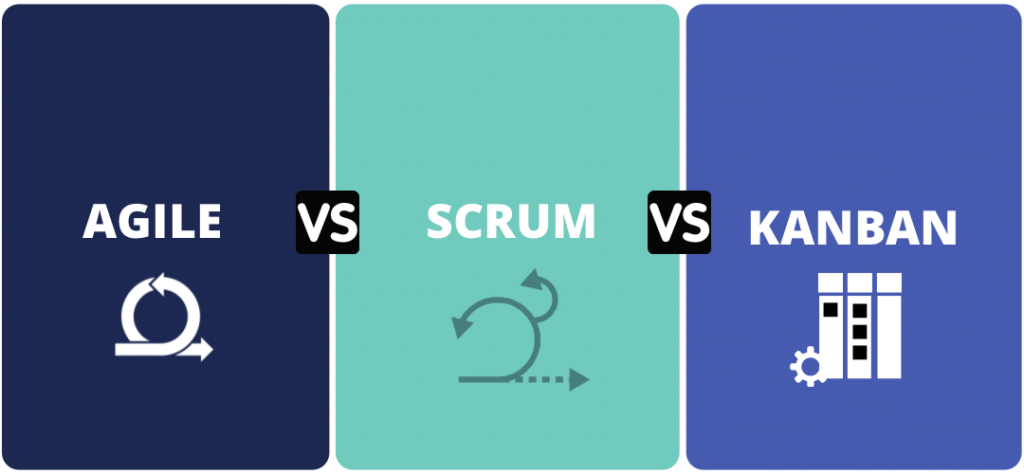
Introduction In the fast-paced world of work and project management, being agile is crucial. To help with this, three popular methods have emerged: SAFe, Scrum, and Kanban. They each have their unique ways of getting things done, and it’s important to know how they differ. In this blog, we’ll break down the key points of SAFe, Scrum, and Kanban to help you figure out which one might work best for your team. 1. SAFe (Scaled Agile Framework) SAFe is all about handling big projects in big organizations. It’s like a big toolbox for making sure everyone is on the same page and working together. Here are some things to know about SAFe: Big Scale: SAFe is for really large companies and projects that need lots of people working together. -Roles and Jobs: In SAFe, there are many job titles and roles like Release Train Engineer, Product Owner, and Scrum Master. Each of these roles has a specific job to do. -Events and Stuff: SAFe has meetings and things like Program Increment Planning and Inspect and Adapt workshops to keep everyone on track. -Timing: SAFe likes to work in set time periods, often around 8-12 weeks. This helps all the teams stay in sync. -Some Flexibility: While SAFe has rules, it also allows teams to change things a bit to fit their needs. 2. Scrum Scrum is a straightforward way to get work done. It’s most commonly used for building products but can be used in many fields. Here’s what you need to know about Scrum: -Roles and Jobs: Scrum has three main roles: Scrum Master, Product Owner, and Development Team. Each role has a clear job description. -Events: Scrum is like clockwork. It has set events: Sprint Planning, Daily Scrum, Sprint Review, and Sprint Retrospective. -Things on Paper: Scrum uses lists and plans called Product Backlog, Sprint Backlog, and Increment to keep track of work. -Learn as You Go: Scrum is all about trying things and learning from them. -Fixed Roles and Events: Scrum has strict roles and events that can’t change much, making it easy to follow. 3. Kanban Kanban is all about keeping things moving smoothly. It’s great when your work comes in at different times or needs flexibility. Here are the basics of Kanban: -See the Work: Kanban uses boards with cards to show what needs to be done and what’s already finished. -Limits on Work: It sets limits on how many things can be worked on at once. This stops people from getting overwhelmed. -Never Stops: Unlike Scrum, Kanban doesn’t have fixed time periods. Work flows all the time, and you finish things when you’re ready. -Change It Up: Kanban is really flexible and can fit into all sorts of jobs and situations. -Less Rules: Kanban has fewer rules and roles compared to Scrum, so it’s easy to get started with. Comparing SAFe, Scrum, and Kanban Now, let’s put these three methods side by side: 1. For Big or Small? – SAFe is for big companies and projects. – Scrum and Kanban work well for smaller teams and projects. 2. Who Does What? – SAFe has lots of different roles. – Scrum has three clear roles. – Kanban needs fewer roles. 3. What’s the Schedule? – SAFe and Scrum have set schedules. – Kanban doesn’t have a set schedule; it goes with the flow. 4. Can You Change Things? – SAFe and Scrum have more fixed rules. – Kanban is really flexible. 5. Seeing the Work – Kanban is all about visual boards. – SAFe and Scrum use them but not as much. 6. Limits on Work – Only Kanban sets limits on how many things can be done at once. Conclusion SAFe, Scrum, and Kanban are like different tools in a toolbox. SAFe is for big projects in big organizations, Scrum is straightforward and strict, and Kanban is flexible and flow-oriented. Your choice depends on your team’s size, needs, and how much flexibility you want. Some teams even mix and match these methods to create their own unique approach. The main thing is to keep an open mind and keep improving the way you work to succeed in today’s fast-moving world.
Simple Tips to Excel as a Scrum Master

Introduction In the world of agile project management, a Scrum Master plays a vital role in helping teams succeed. Acting as a guide, coach, and leader, a Scrum Master ensures that teams work well together and achieve great results using the Scrum framework. If you’re aiming to be a great Scrum Master, here are 10 straightforward tips to follow. 1. Know the Scrum Basics To be a good Scrum Master, get familiar with the key parts of Scrum. This means understanding roles like Product Owner, Development Team, and Scrum Master, as well as events like Sprint Planning and Daily Standup. 2. Put the Team First A big part of being a Scrum Master is looking out for the team’s needs. This involves helping the team by solving problems and creating an environment where they can do their best work. 3. Talk and Listen Well Good communication is super important. Listen carefully during meetings and talk in a way that everyone understands. This keeps everyone on the same page and helps solve problems faster. 4. Help Everyone Work Together Teams do best when they work together smoothly. Your job as a Scrum Master is to help everyone get along, share ideas, and work together well. 5. Always Get Better Encourage your team to keep improving. Regularly check how things are going and find ways to make things work even better. This could mean changing how you do things or trying new ideas. 6. Clear the Way Sometimes things get in the team’s way. It’s your job to find those obstacles and remove them, whether they’re big or small. This helps the team move forward without any troubles. 7. Guide the Team As a Scrum Master, you’re like a coach for the team. You help them understand how to use Scrum and encourage them to make their own decisions. 8. Keep Things Positive A happy team does better work. Create a positive atmosphere where people feel safe to share ideas and talk about problems. Celebrate successes and be open to feedback. 9. Lead by Doing Show the team how things are done by your own actions. Be honest about challenges you face and how you overcome them. Your team will learn from you and follow your lead. 10. Stay Flexible and Understanding Things change, and that’s okay. Be ready to change your plans if needed. Also, understand your team members. Everyone has different strengths and struggles, so be there to support them. Conclusion Being a great Scrum Master isn’t just about knowing the rules. It’s about helping your team work well together, making improvements, and creating a positive environment. By understanding the basics of Scrum, putting the team’s needs first, and leading with positivity, you’ll guide your team to success in an ever-changing world.
Making Remote Work Click: Easy Tips for Scrum Masters

Introduction Working from home has changed how teams get things done. For Scrum Masters, who help teams work better together, learning how to lead online meetings is super important. This blog gives simple tips to help Scrum Masters be great at leading remote meetings. Getting Used to Online Leading Because more people are working from home, Scrum Masters need to get good at leading online meetings. This means helping teams do their best work even when they’re not in the same room. 1.Tech Skills: Scrum Masters need to know how to use online tools like video calls and virtual whiteboards. This helps everyone talk and share ideas even when they’re far away. 2.Clear Talking: When you talk, make sure you explain things really well. This way, everyone knows what to do and there’s no confusion. 3.Keeping Everyone Interested: It’s harder to keep people interested in online meetings. Use fun activities and tools like polls to keep everyone involved. Best Ways to Lead Online Meetings 1.Plan It Out: Have a clear plan for your meetings, like what you’ll talk about and how long it will take. Stick to your plan to save time. 2.Use Pictures: Drawings and pictures can help explain things. Use online whiteboards or show pictures on the screen to help everyone understand. 3.Listen Carefully: Pay close attention to what people say, even if they’re not talking loudly. This helps you understand how the team feels and if there are any problems. 4.Get Everyone Involved: Make sure everyone talks and shares their ideas. Encourage quiet people to speak up so that everyone can take part. 5.Different Time Zones: If people are in different time zones, be fair with meeting times. Record meetings for those who can’t join live. Solving Remote Meeting Challenges 1.Can’t See People: When you can’t see people face-to-face, it’s harder to understand their feelings. Ask everyone to turn on their cameras during meetings to feel more connected. 2.Distractions at Home: People might have distractions at home. Tell them to find a quiet place for meetings and focus on work. 3.Tech Issues: Sometimes, technology doesn’t work perfectly. Have a backup plan, like using a different tool or doing things without the computer. 4.People Not Talking: In online meetings, people might be quiet. Use a “take turns” rule to make sure everyone gets to talk. 5.Building Team Bond: Working online makes it harder to get to know each other. Plan some fun online events to help team members connect. Using Agile in Online Work 1.Talk About What Went Well: After a project, talk online about what went well and what could be better. Use online tools to gather everyone’s thoughts. 2.Plan Together: Use online whiteboards to plan what tasks need to be done. Everyone can see and add to the plans. 3.Quick Check-ins: Every day, have a quick online meeting where everyone says what they’re working on. This helps everyone stay connected. Conclusion Leading online meetings is a new skill for Scrum Masters. By using technology, talking clearly, and making meetings fun, Scrum Masters can help teams work great even when they’re far apart. Even though there are challenges, with practice, online meetings become a chance to make teamwork better and help everyone do their best work from anywhere.
Your Guide to Building a Successful Career as a Scrum Master

Introduction In today’s fast-changing tech world, some roles have become super important, and one of these is being a Scrum Master. As businesses adopt agile methods to manage projects better, Scrum Masters have become key players. This article will show you the journey of a Scrum Master’s career, the skills you need at different stages, and tips to do well in this exciting field. The Job of a Scrum Master A Scrum Master takes care of the Scrum framework, which is a set of rules to help teams work together better. Their main job is to make sure the team follows these rules and overcomes any obstacles to do their best work. 1. Starting Out: Building the Basics When you’re new to being a Scrum Master, focus on learning the basics. This means understanding what agile and Scrum are, and how they work. You’ll also need to be good at talking to people and helping them work together, as teamwork and talking are really important in this job. At this stage, getting a certification like Certified ScrumMaster (CSM) or Professional Scrum Master (PSM) can show that you know the basics and are serious about your new role. 2. Getting Better: Making Things Run Smoothly As you get more experience, you’ll start helping the team work even better. You’ll guide them to find ways to improve their work and solve problems faster. Think of yourself as a helper-leader who supports the team and makes sure they have what they need to succeed. In this part of your career, work on being a good helper and solving problems when people in the team don’t agree. Also, learn about other ways of working that are like Scrum, such as Kanban and Lean. 3. Becoming an Expert: Coaching Others With time, you’ll become a coach. This means you’ll not just help your team, but you’ll also teach other Scrum Masters and the people in charge. You’ll help them understand how to use agile methods in bigger ways across the company. At this point, you’ll need to be a really good listener and ask smart questions. You’ll guide people to figure things out on their own. You might also want to get fancier certifications like Certified Scrum Professional (CSP) or ICAgile Certified Professional in Agile Coaching (ICP-ACC). 4. Making a Big Difference: Changing the Whole Company When you’re a pro, you’ll work on even bigger stuff. You’ll talk to bosses and important people in the company to make agile methods part of how the whole company does things. You’ll help them see how agile can make the company better. To do well here, work on being good at planning and helping people accept big changes. You’ll need to show how agile can help the company grow and do better. Conclusion Being a Scrum Master is a journey that keeps on going. From learning the basics to making big changes in the company, each step is important. Keep learning and growing, focus on how you work with people, and be ready to change as the tech world does. Whether you’re starting or moving up, being a Scrum Master lets you be a part of the exciting world of agile project management.
Unveiling the Job of a SAFe Agilist: Making Big Teams Agile

In the speedy world of business today, being able to provide top-notch products and services quickly is super important. To make this happen, many companies are using frameworks like SAFe, which stands for Scaled Agile Framework. In SAFe, a special person called a SAFe Agilist has a really important role. Let’s dig into what they do and why they matter so much in making companies agile. Understanding SAFe: Before we get into the nitty-gritty of what a SAFe Agilist does, let’s quickly understand what SAFe is. SAFe is a way of doing things that helps companies use agile practices across the whole organization. It helps them work together better, improve teamwork, and deliver things faster. With different roles, events, and stuff like that, SAFe is like a roadmap for making big changes in how companies work. Meet the SAFe Agilist: A SAFe Agilist is a super important role in the SAFe framework. They’re like the heroes who help companies become more agile. They do this by making sure everyone understands how to use agile ways of working and by guiding the whole process of change. What a SAFe Agilist Does: 1. Being the Agile Champion: One big thing a SAFe Agilist does is talk about and make sure everyone understands agile ideas. They help people in the company get why agile is cool and how it can help them work better. 2. Leading Agile Teams: SAFe Agilists help teams work in a more agile way. They give them advice, teach them new things, and show them how to get stuff done faster. 3. Helping Teams Plan: SAFe Agilists also help teams plan their work for certain periods, which they call “Program Increments.” They make sure everyone knows what they need to do and that everyone’s on the same page. 4. Getting Everyone to Work Together: SAFe Agilists bring teams and people together. They help technical teams talk to people who need the things they make. This helps make sure the things being made are what customers want. 5. Always Making Things Better: SAFe Agilists help teams find ways to do things better. They listen to what’s going well and what’s not, and then they help everyone get better step by step. 6. Teaching and Helping: SAFe Agilists are like coaches. They teach and help teams and other people in the company learn how to work better. They’re like the friendly guides who show everyone the way. 7. Keeping Track: It’s important to see how well things are going. SAFe Agilists help figure out what things to measure and how to keep track of them. This helps everyone know if they’re doing a good job. 8. Helping with Change: When a company wants to change how it works, it can be hard. SAFe Agilists help with this. They help teams and leaders understand the changes, deal with any worries, and make everyone excited about the new ways of working. What Makes a Good SAFe Agilist: Being a great SAFe Agilist means having certain skills and qualities: -Knowing About Agile: They need to really know about agile stuff, like how it works and why it’s helpful. This way, they can explain it well to others. -Being a Leader: SAFe Agilists need to lead and guide others, even if they don’t have a boss title. Leading means helping others do their best work. -Talking Well: They should be able to explain things in a simple way so that everyone can understand. Good communication helps everyone work together better. -Being Kind: Understanding others’ problems and being kind is super important. This helps build trust and make people feel comfortable asking for help. -Always Learning: The way people work is always changing. Great SAFe Agilists keep learning new things so they can stay helpful. In a nutshell, a SAFe Agilist’s role is super important for making big companies agile. They help teams, leaders, and everyone in between work together better, get things done faster, and deliver awesome stuff. With their guidance, companies can transform and succeed in today’s fast-changing business world.
The 4 Key Values that Make SAFe Work

In the world of making software and managing projects, there’s a method called SAFe that lots of big organizations like to use. It helps them do their work better, faster, and with fewer mistakes. SAFe has four really important values that act like the foundation of its success. These values are like guiding principles that help companies become better at working together, getting things done, and making customers happy. 1. Working Together on the Same Goals One of the most important things in a company is when everyone is working together for the same reasons. SAFe calls this “Alignment.” It’s like when all the people in different teams understand what the company wants to achieve, and they all work in sync to reach those goals. This is like a puzzle where each piece fits perfectly with the others. Strategic Themes: These are like big signs that show the company’s main goals. When everyone knows these goals, they can make decisions that help the company move in the right direction. Planning Together: SAFe suggests that teams should plan their work together in regular meetings. This way, they can figure out how to help each other and avoid problems that might slow them down. 2. Doing Things Right from the Start When we make software or anything else, it’s really important to do it correctly from the beginning. SAFe’s second value, “Built-in Quality,” is all about this. It’s like building a strong foundation for a house so it doesn’t fall apart later. Here’s how SAFe helps with this: No Mistakes Allowed: SAFe encourages using tools that help us catch mistakes before they become big problems. It’s like checking your homework before you hand it in. Working Together: All the people in the team work together to make sure the thing they’re making is good from the very start. This means fewer mistakes and better stuff for customers. 3. Being Open and Honest Imagine if you were playing a game, but nobody told you the rules or what’s happening. That would be confusing, right? In the world of companies and projects, being open and honest is really important. SAFe’s third value, “Transparency,” is like shining a light on everything so everyone knows what’s going on. Here’s how SAFe does it: Seeing Is Believing: SAFe wants teams to use visual tools to show their work and what’s happening. This way, everyone can understand and help if something’s not right. Always Getting Better: SAFe wants teams to talk about what they’re doing and how they can do it better. This helps them learn from their mistakes and become even better. 4. Working as a Team Think about playing a team sport. If everyone works together, they’re more likely to win, right? SAFe’s fourth value, “Collaboration,” is like that. It’s about working as a team, helping each other, and sharing ideas. Here’s what SAFe suggests: All Skills Welcome: SAFe likes teams where people have different skills. This way, they can make something amazing together without needing help from other teams. Learning Together: SAFe thinks it’s cool when people with the same skills learn from each other. This makes everyone better and the team stronger. In the end, SAFe’s four values — Alignment, Built-in Quality, Transparency, and Collaboration — are like the building blocks of a strong and successful way of working. They help companies do their work better, help teams work together without problems, and make sure customers get what they want. SAFe is like a map that guides companies to success by showing them the best ways to work together and make great things.
Prerequisites for Getting SAFe Agilist Certified in 2023

In today’s business world, being flexible and efficient is really important. That’s why many companies are using Agile methods to work better. SAFe, which stands for Scaled Agile Framework, is a popular way for companies to use Agile on a bigger scale. If you want to improve your job opportunities and help your company succeed, you might consider getting the SAFe Agilist certification in 2023. But before you start, it’s good to know what you need to do first. What is SAFe Agilist Certification? Getting SAFe Agilist certified means you’re really good at using Agile in big companies. You can lead teams, help them work together, and make things better all the time. What You Need: To get SAFe Agilist certified in 2023, you should have: 1.Some Basic Agile Knowledge: Before you start, it’s helpful to know a bit about Agile things like Scrum, Kanban, and Lean. This will make it easier to learn the SAFe way of doing things. 2.Work Experience: You should have worked for at least five years in jobs related to software, business, or project management. This makes sure you understand how things work in real work situations. 3.Education: Having a college degree in something like software, business, or information technology is good. If you don’t have a degree, having similar work experience is okay too. 4.Training: You need to finish a special training course about SAFe Agilist things. This course will teach you important stuff like Agile practices and how to lead big changes in a company. 5.Pass a Test: After your training, you’ll need to take a test. This test checks if you really understand SAFe and can use it to make work better. 6.Keep Learning: After you’re certified, it’s smart to keep learning. Agile things change, so it’s good to know the newest ideas and tools. Why Get Certified? Getting the SAFe Agilist certification can help you in many ways: Learn More: You’ll become really skilled in Agile and how to use it in big companies. Find Better Jobs: Companies need people who know SAFe to help them work better. So, you’ll have more job choices. Help Companies: With this certification, you can make companies work smoother, which is good for everyone. Be Known: People all over the world know about SAFe certifications. It shows you’re really good at what you do. In short, to get SAFe Agilist certified in 2023, you should know a bit about Agile, have work experience, finish training, pass a test, and keep learning. This certification can make your job prospects better and make your company do even better too. It’s a great way to grow your career in today’s fast-changing business world.
Navigating Today’s Agile Adoption: Thriving in a Dynamic Project Management Landscape

Introduction In the rapidly evolving world of project management, Agile methodologies have emerged as a transformative force, revolutionizing the way teams collaborate, innovate, and deliver results. Navigating the terrain of modern Agile adoption is a crucial endeavor for organizations aiming to stay competitive, adaptive, and customer-centric. In this blog post, we will embark on a journey to explore the intricacies of Agile adoption in today’s dynamic business environment. Agile Essentials: A Brief Overview Before we dive deeper, let’s briefly outline the fundamental tenets of Agile methodologies. At its core, Agile emphasizes iterative development, frequent feedback, and close collaboration among cross-functional teams. This approach allows teams to respond swiftly to changing requirements, ensuring the delivery of high-quality products or services that align with customer needs. The Changing Landscape: Why Agile Matters Today In an era characterized by rapid technological advancements, shorter product life cycles, and an ever-increasing demand for innovation, Agile methodologies offer a beacon of adaptability. We’ll discuss how Agile’s flexibility addresses the challenges posed by uncertainty and market fluctuations, allowing organizations to pivot, refine, and optimize their projects in real-time. Key Benefits of Agile Adoption: Enhanced Customer Satisfaction: Agile’s customer-centric approach ensures that project outcomes closely align with end-user expectations, resulting in higher satisfaction rates. Continuous Improvement: Through regular iterations and retrospectives, Agile teams foster a culture of continuous learning and enhancement, driving improved processes and outcomes. Accelerated Time-to-Market: Agile practices enable quicker product releases, giving organizations a competitive edge in getting their offerings to market ahead of competitors. Efficient Resource Allocation: Agile’s iterative planning and adaptive scope management help optimize resource utilization and minimize waste. Navigating Challenges: Roadblocks on the Agile Journey While Agile offers numerous advantages, it’s important to acknowledge and address potential challenges. We’ll explore common obstacles such as resistance to change, inadequate team alignment, and the need for robust communication. Strategies for Successful Agile Adoption: Leadership Commitment: Buy-in from leadership is crucial to foster a culture of Agile adoption throughout the organization. Comprehensive Training: Equipping teams with the necessary skills and knowledge ensures a smoother transition to Agile practices. Clear Communication: Open and transparent communication channels enhance collaboration and help overcome resistance. Agile Tools and Frameworks: Leveraging tools and frameworks tailored to Agile methodologies streamlines project management processes. Case Study: A Glimpse into Agile Success We’ll showcase a real-world case study highlighting a company’s successful transition to Agile methodologies. By examining their journey, we can glean insights into the practical implementation of Agile principles and the resulting positive impact on project outcomes. Conclusion In today’s fast-paced business landscape, embracing Agile methodologies is no longer a choice—it’s a necessity. Navigating the nuances of Agile adoption empowers organizations to thrive amidst change, seize opportunities, and achieve sustainable growth. By embracing the principles, benefits, and strategies outlined in this blog post, you’re well on your way to charting a successful course through the dynamic world of modern project management. Stay tuned for more insightful content on Agile practices and other pertinent topics as we continue to explore the ever-evolving realm of project management.
The Winning Duo: Why Scaled Agile and Scrum Are Everywhere

Introduction Imagine building something cool, like a puzzle, but the pieces keep changing shape. That’s how the world of making software and big projects feels today. But guess what? There are two super methods called Scaled Agile and Scrum that help people handle this puzzle and create amazing things. Let’s find out why these methods are so popular in 2023 and how they make things better. 1. Adapting Quickly to Changes Picture a game where the rules change all the time. That’s what business is like now. Scaled Agile and Scrum are like superhero costumes for projects. They help teams change their plans quickly to keep up with the fast-moving world. Instead of getting stuck with old plans, these methods let teams switch things around easily. 2. Teamwork and Talking Together Imagine building a treehouse with your friends. Everyone needs to talk and help each other, right? Scaled Agile and Scrum make teams work like buddies in a treehouse club. They encourage everyone to share ideas and work together. This makes things go faster and helps everyone know what’s happening. 3. Building Bit by Bit with Scrum Have you ever finished a huge puzzle all at once? It’s tough! Scrum breaks big projects into small parts, like solving one puzzle piece at a time. Each small part is like a mini achievement, making the whole project easier to finish. People get to see progress quickly, which is super exciting. 4. Making Big Plans Work with Scaled Agile Imagine you’re directing a play with lots of actors. Scaled Agile is like being the director. It helps organize everyone so they know their parts. It’s not just about one team; it’s about getting everyone in the whole play to work together smoothly. This method makes sure big projects with many teams don’t become a mess. 5. Fast Results and Happy Customers Think about getting a piece of cake after each small task you finish. Yummy, right? Scrum gives that feeling to projects. It helps teams finish parts quickly, so customers get results faster. This makes customers happy and keeps them excited about the project. 6. Changing Plans Easily Imagine making a sandcastle and suddenly a big wave comes. That’s how sudden changes can feel in projects. But with Scaled Agile and Scrum, teams can adjust their plans easily when surprises happen. They don’t panic; they just adapt and keep building. 7. Giving Teams More Power Have you ever played a game where everyone has their role? That’s what Scrum does. It lets each team member have a special role, like a superhero power. This makes everyone feel important and helps the team work better. Conclusion: The Superheroes of Project Building In 2023, Scaled Agile and Scrum are like the superheroes of projects. They help teams handle changes, work together like friends, and create amazing things. By breaking big projects into small steps, making teamwork easy, and letting teams adapt quickly, these methods make the world of building stuff way more fun and successful. So, remember, Scaled Agile and Scrum are here to save the day in the exciting world of projects!
The DevOps Revolution of 2023: Why Businesses Care

In the world of computer stuff and making things work smoothly, something called “DevOps” is a big deal this year, 2023. It’s like a special recipe that helps companies cook up software faster, better, and with fewer mistakes. Let’s dive into why everyone’s talking about DevOps and why it’s super important. 1. Getting Ahead with Speed and Smarts Imagine you’re in a race to create cool stuff for people to use. DevOps gives companies a turbo boost. It helps teams work together like superheroes to build things quicker and smarter. Before, the people who make the software (developers) and the people who run it (operations) didn’t talk much. Now, they’re like best friends who share ideas, helping things happen faster. 2. Happy Customers, Happy Companies Imagine if every time you used an app, it didn’t crash, freeze, or act weird. That would be amazing, right? DevOps helps make this dream come true. It focuses on checking software for mistakes and making sure it works well before releasing it. This means customers are happier because they get to use software that’s not buggy. Happy customers mean companies do better too! 3. Money, Money, Saved Money Running a business is like managing money. DevOps is like a magical money-saving spell. It makes things work so smoothly that businesses spend less time fixing mistakes and more time making great things. With less time wasted, businesses save money and can invest it in exciting new projects. 4. Stopping Trouble Before It Starts Imagine building a sandcastle near the sea. Sometimes a big wave comes and ruins it. DevOps helps companies watch out for those big waves in the software world. By checking things as they’re built, teams can find problems early and fix them. This stops small problems from becoming big disasters. It’s like being a superhero that keeps the day safe! 5. Friends Who Work Together In the past, the people building stuff and the people running it were like neighbors who never said “hi.” DevOps is like inviting them to a big party. It encourages them to share ideas, help each other, and work together. This teamwork makes everything better, and it’s not just about the software—it’s about building a cool community at work. 6. Cloudy with a Chance of Awesome Imagine if you could use your computer stuff from anywhere, like magic. That’s what the cloud does. DevOps and the cloud are like peanut butter and jelly—they’re perfect together. DevOps helps companies use the cloud in a super cool way. It makes things run even smoother, and it’s perfect for businesses that want to grow big. 7. Keeping Bad Guys Out It helps build software that’s tough to crack. With DevOps, security is a top priority. It’s like locking the door to your castle so no dragons can get in and mess things up. Conclusion: DevOps Is the Superhero You Need So, in 2023, DevOps isn’t just a fancy word—it’s a superhero way of doing things. It helps companies work faster, keep customers smiling, save money, and stay safe from trouble. Plus, it brings teams together like the best of friends. Just like your favorite superhero saves the day, DevOps is saving the tech world, one line of code at a time!
Mastering Distributed Agile Development: Navigating Complexity for Global Success

In an era where innovation knows no borders, Distributed Agile Development has emerged as the bridge between Agile methodologies and the challenges of a dispersed workforce. This dynamic approach fuels collaboration, flexibility, and customer focus, even when team members are continents apart. In this blog, we’ll unravel the intricacies of Distributed Agile Development, shed light on the hurdles it presents, and uncover the strategies that pave the path to triumph. Embracing the Essence of Distributed Agile Development Picture Agile methodologies as a guiding compass for modern software development. Now, extend this compass across the world map, where teams collaborate seamlessly despite physical distances. Distributed Agile Development encapsulates the spirit of Agile in a globe-spanning context, fostering iterative progress, harmonious teamwork, and the adaptability needed to conquer geographical divides. Navigating the Seas of Challenges 1.Communication Jigsaw: Effective communication is the heartbeat of any project. In distributed settings, the jigsaw of conveying ideas, feedback, and updates becomes even more intricate. Language barriers and time zone disparities can lead to communication breakdowns. 2.Time Zones, Time Travels: The sun never sets on global development, but it does cast complex shadows. Working across time zones requires choreography to synchronize meetings, decisions, and collaboration. A dance with time zones often becomes a routine. 3.Culture Clash and Harmony: With diverse talents come diverse cultures, each adding a unique hue to the canvas. Yet, these cultural shades can sometimes create clashes, demanding a blend of understanding, empathy, and patience to achieve harmony. 4.The Missing Handshake: Agile thrives on face-to-face interactions, but digital spaces replace handshakes with pixels. While video calls and virtual platforms bridge gaps, they can’t replicate the energy of a shared room. 5.Technology: Ally or Adversary: A digital thread ties distributed teams, but it’s a thread vulnerable to glitches. Robust tech infrastructure is vital, as technical hiccups can disrupt the rhythm of collaboration. 6.Team Bonding, Virtually: Team cohesion takes on a digital persona, requiring creativity to nurture camaraderie. Building trust through screens and fostering a shared sense of purpose demands innovative approaches. Charting the Course to Triumph 1.Tools of Connectivity: Leverage a toolbox of collaboration tech, including video conferencing, instant messaging, and project management platforms. Craft a communication blueprint to ensure everyone stays in sync. 2.Tech as the North Star: Equip your teams with cutting-edge collaboration tools that pave the way for real-time engagement, seamless task tracking, and knowledge dissemination. Tech is the compass guiding your distributed voyage. 3.Time Zone Synergy: Identify time slots that accommodate different time zones, ensuring a unified platform for discussions and decisions. Your carefully plotted course should align work hours for smooth sailing. 4.Cultural Intelligence: Embrace a learning culture that values diverse perspectives. Equip your crew with cultural insights, allowing them to navigate cultural waters with grace and appreciation. 5.Agile Flex: Tailored Sprints: Adapt Agile practices to suit your distributed fleet. Virtual stand-ups, refined sprint planning, and meticulous alignment with Agile principles will fine-tune your journey. 6. Documentation Anchors: Establish a central repository for project knowledge and documentation. This digital anchor ensures that all hands on deck have access to vital information, regardless of their location. 7.Reflect and Refine: Regular retrospectives steer your ship toward continuous improvement. Evaluate processes, communication strategies, and collaboration methods to chart a course of refinement. 8.Virtual Crew Bonding: While distant, your team’s camaraderie is essential. Organize virtual team-building ventures, celebrate successes, and amplify individual contributions, fostering a sense of unity. Conquering Horizons Distributed Agile Development is more than a methodology; it’s an odyssey that conquers geographical frontiers. It beckons organizations to be agile in mindset and nimble in approach, blending technology, culture, and innovation into a seamless voyage. By embracing these challenges head-on and weaving a tapestry of collaboration, organizations can sail the tumultuous waters of a distributed world and chart a course towards unparalleled triumph.
Embracing Agility: Navigating the Future of Software Development

Introduction: Software development has undergone a transformative journey in recent years, with Agile methodologies leading the charge. Agile’s innovative principles, which prioritize flexibility, collaboration, and customer-centricity, have redefined how teams approach development projects. However, as we peer into the horizon of software development, we must ask ourselves: does Agile have what it takes to stay relevant in the ever-changing landscape? The Agile Revolution: The roots of Agile can be traced back to 2001 when a group of forward-thinking developers crafted the Agile Manifesto. This manifesto emphasized valuing individuals and interactions, delivering working software over documentation, collaborating with customers, and being responsive to change. These core values struck a chord within the development community and spurred the rise of Agile methodologies like Scrum, Kanban, and Extreme Programming. Navigating the Challenges: While Agile has brought tremendous benefits, it has not been without its fair share of challenges. One of the primary hurdles is its implementation within traditional organizational structures. Embracing Agile requires a cultural shift, as it demands empowerment, self-organization, and cross-functional collaboration. Overcoming resistance and aligning company-wide practices with Agile principles can be a formidable task. Moreover, the notion that Agile fits all projects equally has been questioned. While Agile excels in iterative development and managing evolving requirements, some large, complex projects may find the frequent feedback and adjustments more burdensome than advantageous. Hybrid Approaches – The Middle Path: In response to these challenges, many development teams have adopted hybrid approaches. By blending elements of Agile with traditional methodologies, teams can tailor their processes to specific project needs. This flexibility allows them to embrace Agile’s adaptability while retaining certain structures that suit their circumstances. Scaling Agile – Beyond the Team: Agile’s initial success within small teams sparked the desire to scale it across entire organizations. To accommodate this, frameworks like SAFe and LeSS were introduced. These frameworks provide a structured way to align multiple teams, departments, and stakeholders, ensuring a synchronized approach to large-scale projects while preserving the essence of Agile. The Tech-Driven Future: As technology continues to progress at a breakneck pace, software development faces exciting new opportunities and challenges. The rise of artificial intelligence, machine learning, and automation has the potential to transform how software is built, tested, and deployed. Agile will need to incorporate these advancements while maintaining its focus on iterative progress and continuous improvement. Remote Work and Virtual Collaboration: Recent global events have thrust remote work into the spotlight, forcing teams to adapt quickly to virtual collaboration. Agile teams are no exception, and the future of Agile will likely be shaped by the tools and practices that facilitate seamless remote collaboration and communication. Customer-Centricity Remains Paramount: At the heart of Agile lies the customer. As businesses strive to meet evolving customer demands and preferences, Agile must remain steadfast in its commitment to customer-centricity. The ability to respond swiftly to customer feedback and changing market conditions will be a defining factor in Agile’s future relevance. Conclusion: The future of Agile is not set in stone, but its adaptability and resilience suggest it will continue to thrive in the ever-changing world of software development. Challenges notwithstanding, Agile’s core principles and values provide a solid foundation for navigating the uncertainties that lie ahead. Whether through hybrid approaches, scaling to the enterprise level, embracing emerging technologies, or adapting to remote work, Agile is poised to remain a driving force in empowering teams to build better software, faster and with a stronger focus on customer satisfaction.
Navigating the Ever-Evolving Landscape of SAFe Agile

Introduction: In the dynamic world of software development and project management, Agile methodologies have become a beacon of efficiency and adaptability. Among these frameworks, Scaled Agile Framework (SAFe) has emerged as a robust approach to scaling Agile practices across large enterprises. As we look ahead, it is essential to envision the future of SAFe Agile and how it will continue to evolve to address new challenges. In this blog, we will explore the exciting prospects and trends that lie ahead for SAFe Agile. 1. Expanding Beyond IT: While Agile methodologies have primarily found their roots in IT and software development, the future of SAFe Agile will see its boundaries expand. Non-technical domains such as marketing, finance, and HR are increasingly recognizing the benefits of Agile approaches. SAFe Agile will need to adapt and cater to the unique requirements of these diverse domains, giving rise to tailored SAFe configurations for various industries. 2. The Marriage of Agile and DevOps: The relationship between Agile and DevOps has always been close, but the future will witness a deeper integration. The collaboration between these two approaches will create a seamless flow of value from ideation to deployment. By emphasizing continuous feedback loops and automation, this integration will further optimize the product development lifecycle, enabling organizations to deliver faster and more reliably. 3. Putting Customers First: Customer expectations are ever-changing, and organizations must align their strategies accordingly. In the future, SAFe Agile will prioritize customer-centricity, encouraging businesses to gather real-time feedback and iterate quickly. This shift in focus will foster a culture of empathy, enabling enterprises to remain competitive in a customer-driven market. 4. Embracing AI and Automation: As AI and automation continue to advance, they present new opportunities for software development and delivery. The future of SAFe Agile will involve the seamless integration of these technologies to streamline repetitive tasks, gain data-driven insights, and enhance decision-making processes. This collaboration will undoubtedly boost development efficiency and product quality. 5. Adapting to Remote Workforces: The global pandemic has reshaped the way we work, with remote and distributed teams becoming the norm. In the future, SAFe Agile will need to address the challenges of managing dispersed teams effectively. This will require the development of virtual collaboration tools, remote-friendly agile ceremonies, and communication practices that cater to the needs of remote workers. 6. Scaling Agile for SMEs: While SAFe Agile has traditionally been viewed as suitable for large enterprises, the future will witness its adoption in small and medium-sized organizations. To accommodate this shift, SAFe Agile will need to offer lighter and more flexible versions tailored to the scale and complexity of SMEs. This will enable smaller businesses to benefit from Agile practices without overwhelming their teams. 7. Evolving Certification Programs: Certifications have played a significant role in validating the expertise of Agile professionals. In the future, SAFe Agile certifications will evolve to align with emerging industry trends, introducing new roles, skills, and best practices. This will ensure that professionals and organizations stay updated with the latest developments in SAFe Agile. Conclusion: The future of SAFe Agile is one of adaptability and innovation. As Agile principles continue to penetrate various domains, and technology continues to progress, SAFe Agile will remain at the forefront of empowering organizations to meet their evolving needs successfully. By embracing customer-centricity, integrating with DevOps, and leveraging cutting-edge technologies like AI, SAFe Agile will continue to facilitate excellence in delivering value and driving innovation across industries.
Navigating the Waters of SAFe Agile: Overcoming Obstacles on the Path to Success
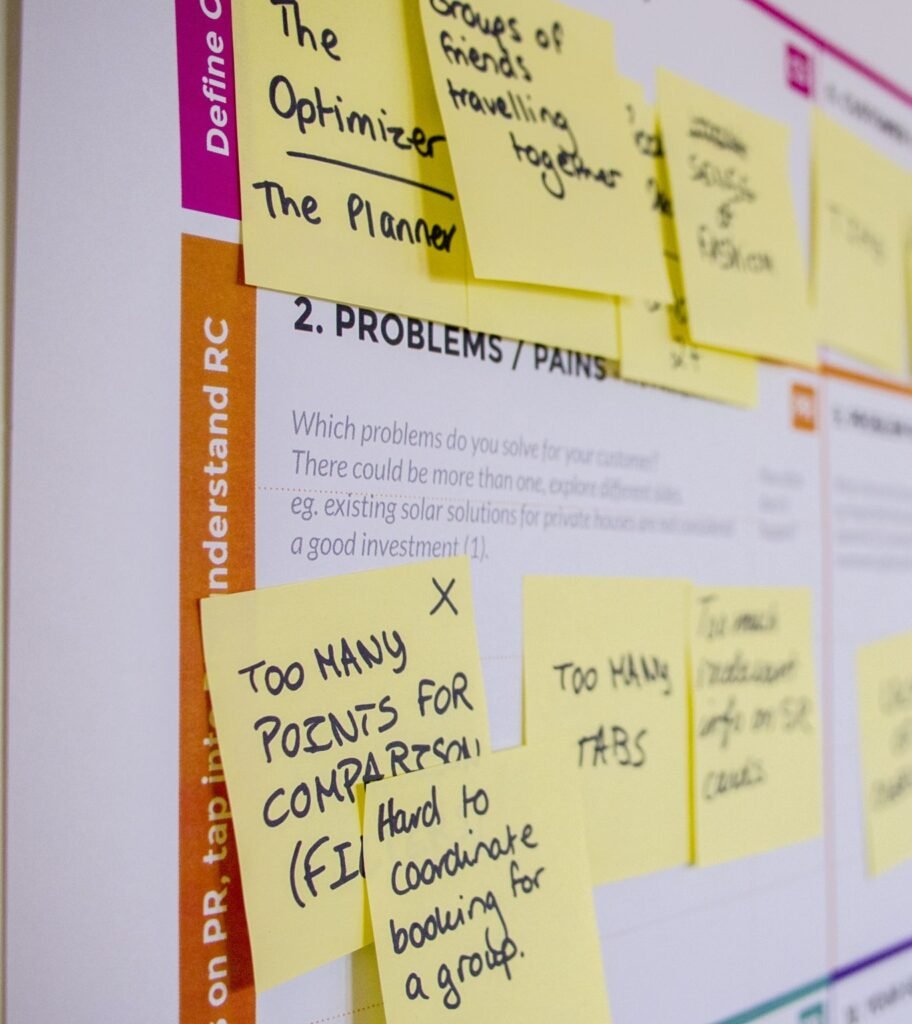
Introduction As businesses strive to stay agile and adaptive in a dynamic marketplace, the Scaled Agile Framework (SAFe) has emerged as a powerful ally. However, like any transformative journey, implementing SAFe Agile is not without its share of challenges. In this blog, we will explore the obstacles that organizations may encounter while embracing SAFe Agile and discuss effective strategies to overcome these hurdles on the road to success. 1) Cultural Shift and Change Resistance One of the primary challenges in adopting SAFe Agile is instigating a cultural shift within the organization. This shift involves moving away from traditional command-and-control structures to fostering a collaborative, cross-functional, and empowered team environment. Resistance to change from employees accustomed to established practices and hierarchies can hinder progress. Overcoming the challenge: Leadership Buy-In: Ensuring top-level management support and active involvement is crucial to driving cultural change. Leaders should exemplify the new values and champion the adoption of SAFe Agile. Communication and Education: Transparently communicate the purpose and benefits of SAFe Agile to employees at all levels. Offer training and workshops to help employees understand the transformation and how they can contribute to its success. Incentivize and Celebrate: Recognize and reward teams and individuals who embrace the cultural shift and showcase positive outcomes. Celebrating small successes along the way can foster enthusiasm and motivate others to join in. 2) Complex Scaling While SAFe Agile is designed to scale across organizations of varying sizes, scaling up can introduce complexities. As the number of teams and stakeholders grows, ensuring alignment, collaboration, and communication can become more challenging. Overcoming the challenge: 3) Integration with Existing Processes Organizations with established processes may encounter resistance when integrating SAFe Agile practices with their current systems. Overcoming the challenge: 4) Ambiguity in Roles and Responsibilities With the introduction of SAFe Agile, traditional roles may undergo modifications, leading to confusion and uncertainty among team members. Overcoming the challenge: 5) Striking a Balance between Compliance and Flexibility While adhering to the SAFe Agile framework is essential, overly rigid compliance can stifle creativity and adaptability. Overcoming the challenge: Conclusion The journey to adopt SAFe Agile presents organizations with various challenges, from cultural shifts to scaling complexities and integration hurdles. However, by recognizing these obstacles and employing strategic approaches to overcome them, organizations can successfully embrace the power of SAFe Agile. A resilient culture, clear communication, and a commitment to continuous improvement will enable organizations to navigate the path to success, reaping the rewards of enhanced collaboration, faster innovation, and sustained growth in today’s rapidly changing business landscape.
Title: Unleashing the Power of SAFe Agile: Navigating the Complexities of Today’s Business Landscape
Introduction In a world where change is constant, businesses face numerous challenges in staying ahead of the curve.This is where the Scaled Agile Framework (SAFe) emerges as a powerful ally. In this blog, we will dive into the myriad benefits of SAFe Agile and explore how it equips organizations with the tools to adapt, flourish, and achieve sustainable growth. 1. Fostering Collaboration and Clear Communication The heart of SAFe Agile lies in fostering a culture of collaboration and open communication. By uniting teams, stakeholders, and management under a shared vision and common goals, SAFe creates an environment where ideas flow freely, leading to faster decision-making and a reduced risk of miscommunication. 2. Accelerating Time-to-Market The essence of SAFe Agile lies in its ability to expedite time-to-market. By embracing incremental development and regular iterations, organizations can swiftly deliver functional products and updates. This rapid pace enables businesses to meet customer demands promptly and adapt quickly to changing market needs. 3. Elevating Product Quality SAFe Agile places a strong emphasis on product quality throughout the development process. Through continuous integration and automated testing, defects are identified and addressed early, leading to improved product quality and customer satisfaction. 4. Predictable and Reliable Outcomes SAFe Agile’s structured approach to planning and execution provides organizations with predictability and reliability in their project outcomes. Regular iterations and release cycles offer insights into progress, allowing teams to identify potential roadblocks and make necessary adjustments, ensuring projects stay on track. 5. Aligned with Strategic Business Goals SAFe Agile takes a customer-centric approach, aligning every effort with the organization’s strategic business objectives. This alignment ensures that development efforts are focused on delivering value to customers, driving business growth, and maintaining a competitive edge. 6. Igniting Employee Engagement SAFe Agile empowers team members by fostering ownership and autonomy in their work. When employees have a say in how they approach tasks and are given the authority to make decisions, their engagement and motivation soar. This heightened commitment leads to increased creativity, innovation, and a more harmonious work environment. 7. Scalability and Flexibility Adaptability is a hallmark of SAFe Agile. The framework can seamlessly scale to meet the needs of organizations of all sizes, making it suitable for startups as well as large enterprises. SAFe Agile facilitates the integration of multiple teams and projects, enabling organizations to operate as a unified force. 8. Mitigating Risks The incremental nature of SAFe Agile development mitigates risks associated with large-scale product releases. Frequent delivery of tested increments allows teams to detect potential issues early and address them before they escalate into major setbacks. 9. Embracing Transparency Transparency is a vital pillar of SAFe Agile. The framework provides clear visibility into project progress through metrics, reporting, and regular ceremonies, promoting accountability and building trust among stakeholders. 10. Cultivating a Culture of Continuous Improvement SAFe Agile nurtures a culture of continuous improvement. Teams are encouraged to regularly reflect on their processes, identify areas for enhancement, and implement changes that drive productivity and efficiency. Conclusion In today’s dynamic business landscape, embracing the power of the Scaled Agile Framework (SAFe) can be a transformative strategy. The benefits of SAFe Agile, from encouraging collaboration and accelerating time-to-market to elevating product quality and igniting employee engagement, position organizations to thrive amidst complexity. By adopting SAFe Agile, businesses can unlock their true potential for innovation, deliver exceptional value to their customers, and pave the way for enduring success.
Title: Scaling Agile with SAFe: A Roadmap to Achieving Organizational Agility
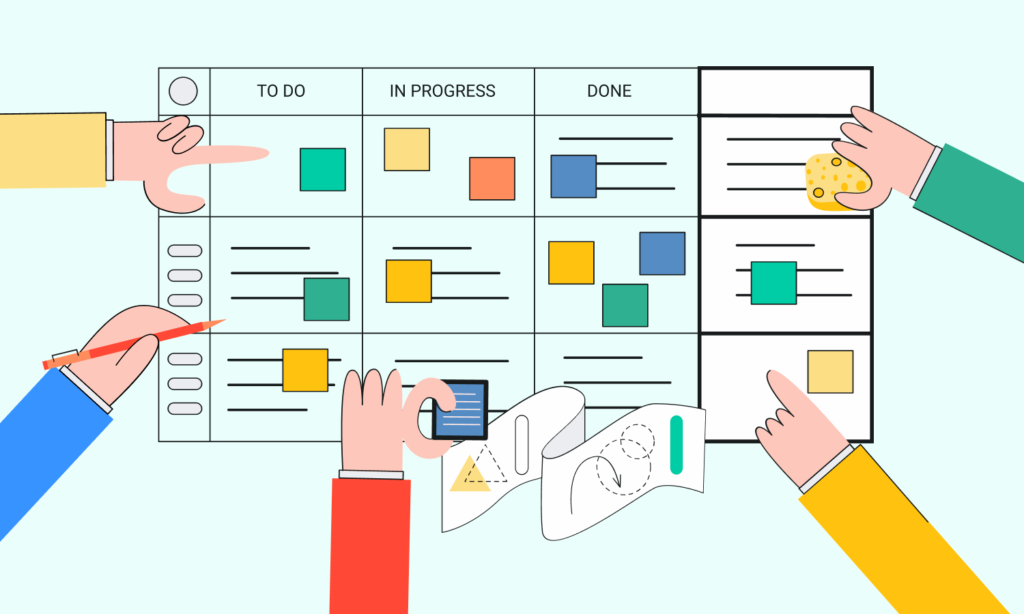
Introduction In the fast-paced and competitive business world, agility is a critical factor for success. While Agile methodologies have proven effective for small teams, scaling Agile practices to large enterprises is a different challenge altogether. The Scaled Agile Framework (SAFe) provides a structured and proven approach to achieve enterprise-level agility. In this blog post, we will explore a step-by-step roadmap to successfully implement SAFe Agile within your organization. Step 1: Assess Your Current State To begin the SAFe implementation journey, it is essential to gain a clear understanding of your organization’s current state. Evaluate your existing Agile practices, identify bottlenecks, and acknowledge areas where improvements are needed. Engage stakeholders from all levels of the organization to gather diverse perspectives, as this will help you build a comprehensive picture of your organization’s strengths and weaknesses. Step 2: Define Your Goals Once you have assessed your organization’s Agile maturity, it’s time to set specific and achievable goals for the SAFe implementation. Align these goals with your organization’s strategic objectives to ensure that the transformation is in line with the broader vision. Common objectives could include faster time-to-market, improved product quality, increased customer satisfaction, and enhanced collaboration between teams. Step 3: Assemble the SAFe Implementation Team Implementing SAFe requires a dedicated team of change agents and Agile experts. Form a SAFe Implementation Team that comprises Agile coaches, transformation specialists, and leaders from various departments. This team will be instrumental in driving the transformation, providing guidance, and fostering a culture of continuous improvement. Step 4: Educate and Train Your Workforce The success of any organizational change hinges on the knowledge and skills of the workforce. Invest in SAFe training and workshops tailored to different roles within your organization. These sessions will help employees understand the principles and practices of SAFe Agile, align everyone on a common language, and ensure a smooth transition. Step 5: Create Agile Release Trains (ARTs) One of the foundational elements of SAFe is the creation of Agile Release Trains (ARTs). ARTs are long-lived teams of Agile teams that work together to deliver value in a synchronized manner. Organize your workforce into ARTs based on value streams, ensuring that each ART has a clear mission and vision aligned with your organization’s objectives. Step 6: Organize Agile Teams Within each ART, organize Agile teams that are cross-functional and self-sufficient. Appoint Product Owners and Scrum Masters to support and guide the teams, fostering an environment where innovation and collaboration thrive. Step 7: Implement Program Increment (PI) Planning PI Planning is a crucial event in SAFe, where all teams within an ART come together to plan their work for a fixed period, typically 8-12 weeks. Use this ceremony to establish alignment, prioritize features, and ensure that everyone is working towards the same objectives. PI Planning fosters collaboration and visibility across the organization. Step 8: Cultivate a Culture of Continuous Improvement To sustain the benefits of SAFe Agile, promote a culture of continuous improvement. Encourage teams to conduct regular retrospectives to reflect on their processes, celebrate successes, and identify areas for growth. Foster a safe environment where experimentation and learning from failures are encouraged. Step 9: Integrate DevOps Practices To optimize the Agile delivery pipeline, integrate DevOps practices into your SAFe implementation. Facilitate collaboration between development and operations teams, automate deployments, and adopt continuous integration and continuous delivery (CI/CD) practices. This integration will streamline the software delivery process and increase responsiveness to customer needs. Step 10: Measure and Adapt Measure the progress of your SAFe implementation using relevant metrics, such as lead time, customer satisfaction, and business value delivered. Use this data to identify areas that require improvement and to celebrate achievements. Be prepared to adapt your approach as you learn from your experiences, making necessary adjustments to optimize your SAFe Agile implementation. Conclusion Implementing SAFe Agile is a transformative journey that requires commitment, collaboration, and a focus on continuous improvement. By thoroughly assessing your current state, defining clear goals, educating your workforce, organizing Agile Release Trains, and fostering a culture of learning and adaptation, you can successfully scale Agile practices across your organization. Embrace the principles of SAFe Agile, be open to change, and empower your teams to deliver value with speed, quality, and customer-centricity. Through SAFe Agile, your organization can thrive in an ever-changing business landscape and stay ahead of the competition.
Embracing Agile at Scale: Demystifying SAFe’s Artifacts and Ceremonies

Introduction In the fast-paced world of software development, achieving agility at scale is a challenge faced by many organizations. The Scaled Agile Framework (SAFe) has emerged as a powerful solution, providing a structured approach to navigate the complexities of large enterprises. Central to SAFe’s success are its well-defined artifacts and ceremonies, which serve as essential building blocks for collaboration, alignment, and seamless communication. In this blog, we will explore the key artifacts and ceremonies in SAFe and how they contribute to fostering an agile culture within organizations. 1. Unveiling SAFe’s Artifacts 1.1 Program Increment (PI) Objectives The Program Increment (PI) is a fixed-length timebox that typically spans 8-12 weeks, during which Agile Teams collaborate to deliver valuable outcomes. The PI Objectives are crucial artifacts that outline the specific goals the teams aim to achieve within the PI duration. Aligned with strategic business objectives, these objectives provide a clear roadmap, enabling teams to work collectively towards shared priorities. 1.2 Program Backlog The Program Backlog encompasses all the features, enablers, and user stories that the Agile Release Train (ART) aims to deliver during the PI. Continuously refined and prioritized by Product Management in collaboration with Agile Teams, the Program Backlog ensures that work items are sequenced based on value and urgency. It acts as a guiding light for teams, fostering focus and enabling efficient value delivery. 1.3 Iteration Goals In SAFe, iterations are fixed-length timeboxes, usually lasting two weeks. Iteration Goals are artifacts that define the specific outcomes Agile Teams strive to achieve during each iteration. These goals act as beacons, guiding teams towards a common purpose and ensuring a sense of direction and purpose throughout the development process. 1.4 Program Kanban The Program Kanban is a visual management tool that provides real-time insights into the flow of work across various stages of development. By visualizing the status of features and stories, the Program Kanban facilitates transparency and empowers teams and stakeholders to identify bottlenecks, address challenges, and make informed decisions. 2. Embracing SAFe’s Ceremonies 2.1 Program Increment (PI) Planning PI Planning is a pivotal ceremony that takes place at the start of each Program Increment. It gathers all members of the Agile Release Train, including Agile Teams, Scrum Masters, Product Owners, and stakeholders. Over a two-day event, participants collaboratively plan the work to be accomplished in the upcoming PI. PI Planning fosters alignment, collective commitment, and a shared understanding of priorities, setting the stage for successful value delivery. 2.2 Iteration Planning At the beginning of each iteration, the Agile Team, Scrum Master, and Product Owner participate in the Iteration Planning ceremony. Together, they review the features and stories in the Iteration Backlog, define iteration goals, and decide on the tasks they will undertake during the iteration. This ceremony promotes collaboration and ensures that the team stays focused on delivering valuable outcomes. 2.3 Daily Stand-ups Daily Stand-ups, or Daily Scrums, are brief and time-boxed meetings that occur daily during an iteration. Agile Teams come together to discuss progress, share updates, and identify potential roadblocks. This daily synchronization fosters communication, transparency, and a sense of shared responsibility within the team. 2.4 Iteration Review The Iteration Review, also known as the Iteration Demo, occurs at the end of each iteration. The Agile Team showcases the completed features and stories to stakeholders, gaining valuable feedback. This ceremony promotes transparency, enables stakeholders to provide input, and validates whether the team has achieved the iteration goals. 2.5 Inspect and Adapt (I&A) The Inspect and Adapt (I&A) workshop marks the end of each Program Increment. During this workshop, all members of the ART and key stakeholders come together to reflect on the performance of the PI. The I&A workshop identifies successes, areas for improvement, and actionable insights to enhance future PIs. Conclusion SAFe’s well-defined artifacts and ceremonies provide a structured and systematic approach to agile at scale, enabling organizations to navigate the complexities of large enterprises successfully. By embracing these key elements, organizations can foster a culture of collaboration, alignment, and continuous improvement, driving their journey towards agile excellence. SAFe’s emphasis on clear communication, shared ownership, and continuous learning empowers teams to adapt, innovate, and excel in delivering value in today’s competitive landscape.
Navigating SAFe: Unveiling the Roles and Responsibilities in Agile at Scale
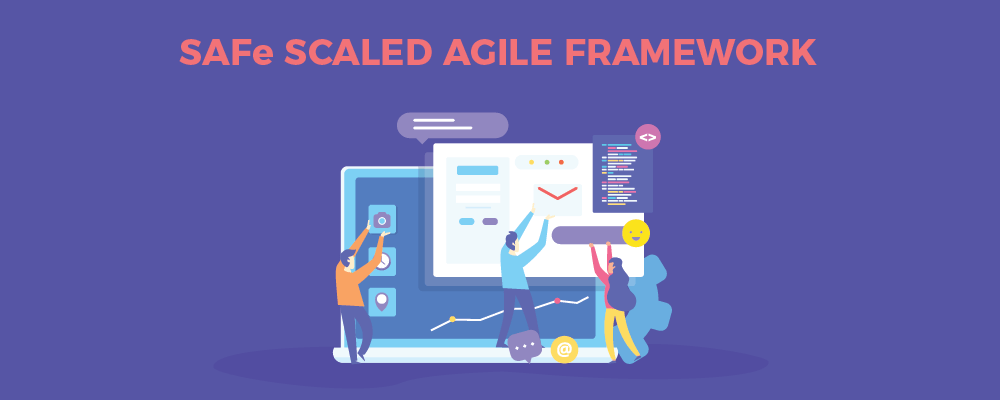
Introduction In the rapidly evolving world of software development, businesses are on a constant quest for efficient approaches to deliver value while staying competitive. Enter the Scaled Agile Framework (SAFe), a comprehensive and proven method to achieve agility at scale. Key to SAFe’s triumph is the clear definition of roles and responsibilities, ensuring seamless collaboration, alignment, and execution across large enterprises. In this blog, we’ll dive into the essential roles within SAFe and explore how they contribute to successful agile transformations. 1. Agile Team Level 1.1 The Agile Team At the heart of SAFe are Agile Teams, small cross-functional groups of dedicated professionals accountable for delivering valuable increments of work. These teams, comprising 5-9 members, including developers, testers, and specialists, embrace iterative and incremental approaches, adhering to Agile Manifesto principles and practices like Scrum or Kanban. 1.2 Scrum Master The Scrum Master acts as both servant-leader and Agile Team facilitator, ensuring adherence to Scrum principles and values. Their primary focus is on removing obstacles, nurturing collaboration, and fostering continuous improvement within the team. 1.3 Product Owner The Product Owner serves as the voice of the customer, responsible for maximizing the value of the Agile Team’s work. By prioritizing the backlog, defining user stories, and providing clear requirements, the Product Owner ensures that the team delivers the right features at the right time. image credits to scaled agile 2. Program Level 2.1 Release Train Engineer (RTE) At the Program Level, the RTE steps into the role of a servant-leader, facilitating Agile Release Trains (ARTs). Their primary responsibility is to ensure the smooth execution of program-level events, coordinate inter-team dependencies, and remove impediments to ensure successful delivery. 2.2 Product Management Collaborating closely with Product Owners, Product Management defines the vision, roadmap, and features of the product. Their role is critical in aligning business objectives with customer needs, driving the development of valuable products. 2.3 System Architect/Engineer The System Architect or Engineer provides technical guidance and assists in making architectural decisions at the program level. Ensuring that the solutions developed by Agile Teams align with the larger enterprise architecture is a vital aspect of their role. 3. Large Solution Level 3.1 Solution Train Engineer (STE) At the Large Solution Level, the STE assumes the role of chief servant-leader, responsible for ensuring alignment, coordination, and successful solution delivery. They facilitate communication between Agile Release Trains and address dependencies across value streams. 3.2 Solution Management Working hand-in-hand with Product Management, Solution Management defines the vision and roadmap of the large solution. Collaborating with stakeholders, they ensure a cohesive strategy that drives value delivery. 3.3 Solution Architect/Engineer Similar to the role at the Program Level, the Solution Architect/Engineer ensures that the overall solution aligns with the enterprise architecture. Their technical expertise guides Agile Release Trains in delivering integrated solutions. 4. Portfolio Level 4.1 Lean Portfolio Management (LPM) At the Portfolio Level, LPM establishes strategy and investment funding, aligning portfolio execution with the organization’s strategic goals. They oversee resource allocation, track progress, and make informed decisions to maximize portfolio value. Conclusion In conclusion, implementing SAFe successfully in an organization rests on understanding and embracing the defined roles and responsibilities. Each role plays a pivotal part in fostering collaboration, alignment, and value delivery at various organizational levels. By empowering individuals in their respective roles, enterprises can effectively navigate the challenges of scaling agile, leading to excellence in software development efforts. SAFe empowers organizations to create a culture of continuous improvement, innovation, and customer-centricity, ultimately driving business success amidst the ever-changing market landscape.
The Five Levels of SAFe: Scaling Agile for Success in the Enterprise

Introduction:In today’s dynamic business environment, organizations are increasingly adopting Agile methodologies to enhance productivity, foster innovation, and deliver exceptional value to customers. However, scaling Agile practices across large enterprises requires a comprehensive approach. Enter the Scaled Agile Framework (SAFe), a widely embraced framework that enables organizations to effectively scale Agile practices from teams to the enterprise level. At the core of SAFe are the Five Levels, each offering a distinct focus and set of practices. In this blog post, we will delve into the Five Levels of SAFe and explore their contributions to achieving enterprise agility and success. image credits to: Scaled Agile Level 1: TeamAt the Team level, SAFe concentrates on empowering individual Agile teams to deliver value. Agile teams collaborate in iterative and incremental ways, utilizing methodologies such as Scrum or Kanban. Emphasis is placed on continuous integration, automated testing, and shared code ownership to ensure efficient and high-quality delivery. Level 2: ProgramThe Program level in SAFe centers around coordinating multiple Agile teams that work towards a common mission or product. The Agile Release Train (ART) acts as the primary organizing structure, aligning teams, synchronizing their efforts, and facilitating efficient delivery. Features and user stories are prioritized, planned, and delivered within Program Increments (PIs), enabling a continuous flow of value. Level 3: Value StreamThe Value Stream level focuses on optimizing the end-to-end flow of value across the enterprise. It encompasses multiple Agile Release Trains and involves stakeholders responsible for delivering a solution. SAFe promotes a customer-centric approach, ensuring that value streams are fine-tuned to effectively meet customer needs. Value Stream Engineers and Product Management collaborate to identify value streams, eliminate bottlenecks, and streamline the flow of value from ideation to delivery. Level 4: Large SolutionThe Large Solution level zeroes in on developing and delivering complex, interconnected solutions that necessitate coordination across multiple value streams. It involves integrating multiple ARTs and engaging with suppliers to foster seamless collaboration. Agile Portfolio Operations play a pivotal role in aligning business strategy, managing dependencies, and facilitating the successful delivery of large-scale solutions. Level 5: EnterpriseAt the Enterprise level, SAFe addresses strategic agility and organizational transformation. It entails aligning business strategy with the Agile delivery model, fostering a culture of continuous learning and improvement, and embracing Lean-Agile principles throughout the organization. Agile Release Trains are constantly evaluated and adjusted to align with evolving business needs, ensuring the enterprise remains adaptable, innovative, and customer-focused. Benefits of the Five Levels of SAFe: Conclusion:As organizations strive for enterprise-wide agility, the Five Levels of SAFe provide a robust framework to scale Agile practices effectively. From empowering individual teams to aligning business strategy with Lean-Agile principles, SAFe offers a comprehensive approach to driving success in large-scale Agile transformations. By embracing the Five Levels of SAFe, organizations can unlock the full potential of Agile, achieve faster time-to-market, and deliver customer value with greater efficiency and effectiveness.
Embracing the Power of SAFe Agile: Four Principles for Success

Introduction: In today’s dynamic business environment, organizations strive to adopt agile methodologies that enable them to stay ahead of the competition, respond to customer demands, and drive innovation. Among the various frameworks available, the Scaled Agile Framework (SAFe) has emerged as a leading choice for scaling agile practices across large enterprises. At the core of SAFe lies a set of four fundamental principles that serve as guiding beacons for successful implementation. In this blog, we will explore these four principles of SAFe Agile and understand their significance in fostering transformational change. Principle 1: Value-Centric Decision Making: The first principle of SAFe Agile encourages organizations to adopt a value-centric approach to decision making. This principle emphasizes the importance of understanding and aligning with the economic drivers of the business. By focusing on delivering value to customers and aligning efforts with business objectives, organizations can prioritize initiatives based on their potential return on investment. This principle promotes a culture of making informed choices that maximize value creation and drive sustainable growth. Principle 2: Embracing Systems Thinking: The second principle of SAFe Agile highlights the significance of embracing Systems Thinking. It acknowledges that organizations are complex systems comprising interconnected parts, and changes made in one area can have ripple effects across the entire system. By adopting a holistic perspective, teams can identify interdependencies and bottlenecks, and optimize the flow of value across the value stream. Systems Thinking promotes collaboration, synergy, and a shared understanding of the bigger picture, resulting in improved efficiency and effectiveness. Principle 3: Embracing Change and Flexibility: The third principle of SAFe Agile emphasizes the need to embrace change and foster flexibility. In complex systems, variability and uncertainty are inherent. Instead of rigidly committing to fixed plans, organizations should preserve options and remain adaptable. This principle encourages teams to respond to emerging opportunities and evolving customer needs by adjusting their course of action. By embracing change, organizations can foster innovation, reduce risk, and seize new business opportunities as they arise. Principle 4: Iterative Learning and Continuous Improvement: The fourth principle of SAFe Agile underscores the value of iterative learning and continuous improvement. It advocates for breaking down initiatives into small, manageable increments and delivering value in fast, integrated cycles. This approach allows teams to gather feedback, learn from experiences, and make informed adjustments. By fostering a culture of experimentation and collaboration, organizations can drive innovation, optimize performance, and achieve a competitive edge in the market. Conclusion: SAFe Agile provides organizations with a powerful framework for scaling agile practices and driving enterprise-wide transformation. The four principles of SAFe Agile—Value-Centric Decision Making, Embracing Systems Thinking, Embracing Change and Flexibility, and Iterative Learning and Continuous Improvement—guide organizations in navigating the complexities of the modern business landscape. By embracing these principles, organizations can prioritize value, optimize systems, adapt to change, and foster a culture of learning and innovation. SAFe Agile empowers organizations to thrive in a rapidly changing world, delivering value faster, and maintaining a sustainable competitive advantage.
SAFe Agile: Unleashing Agile Potential at the Enterprise Level

Introduction In a rapidly changing business landscape, organizations need to embrace agility to stay competitive. However, scaling agile practices beyond individual teams can pose significant challenges. This is where SAFe (Scaled Agile Framework) comes into play. SAFe Agile offers a comprehensive framework that enables enterprises to successfully implement and scale agile methodologies. In this blog post, we will explore the fundamentals of SAFe Agile, its core principles, and the key components that make it an invaluable asset for organizations embarking on large-scale agile transformations. 1. Understanding SAFe Agile SAFe Agile is a robust framework designed to help organizations implement agile practices across the enterprise. It provides a structured approach that allows multiple teams to work cohesively while ensuring alignment, collaboration, and efficient delivery of value. SAFe Agile extends the principles of agility beyond individual teams, enabling organizations to maintain adaptability and customer-centricity at scale. 2. Core Principles of SAFe Agile At the heart of SAFe Agile lie several core principles that drive its implementation: a) Lean-Agile Mindset: SAFe Agile emphasizes a continuous improvement mindset, lean thinking, and delivering value to customers. b) Systems Thinking: SAFe Agile promotes holistic thinking, recognizing the interconnectedness and dependencies among various components, teams, and stakeholders. c) Alignment: Aligning all teams and stakeholders towards a common mission and vision, SAFe Agile fosters collaboration, breaks down silos, and ensures synchronized efforts. d) Built-in Quality: SAFe Agile places a strong emphasis on maintaining high-quality standards throughout the entire development process, reducing defects and rework. e) Transparency: SAFe Agile encourages openness and transparency, facilitating effective communication, visibility, and shared understanding across all levels of the organization. f) Program Execution: SAFe Agile supports decentralized decision-making, fast feedback cycles, and iterative development through the implementation of Agile Release Trains (ARTs). 3. Key Components of SAFe Agile SAFe Agile encompasses several key components that work synergistically to enable enterprise-scale agility: a) Agile Release Train (ART): ART is the primary organizing construct in SAFe Agile, bringing together multiple teams aligned to a shared mission and working collaboratively to deliver value within fixed time increments called Program Increments (PIs). b) Program Increment (PI): PI represents a timebox lasting 8-12 weeks during which ARTs plan, execute, and deliver valuable features and functionalities. PI Planning is a crucial event where teams align their efforts, address dependencies, and establish a synchronized roadmap. c) Value Stream: SAFe Agile recognizes the importance of value streams, which encompass all the activities, processes, and stakeholders involved in delivering value to the customer. Mapping and optimizing the value stream ensure efficient value delivery. d) Agile Teams: SAFe Agile promotes the formation of self-organizing, cross-functional teams that work together to deliver value incrementally. These teams follow agile methodologies such as Scrum or Kanban and synchronize their efforts within the ART. e) Continuous Integration and Continuous Deployment (CI/CD): SAFe Agile encourages the adoption of DevOps practices, automated testing, and continuous integration to enable frequent and reliable integration, testing, and deployment of software. 4. Benefits of SAFe Agile Implementing SAFe Agile brings numerous advantages to organizations: a) Improved Collaboration and Alignment: SAFe Agile fosters collaboration, transparency, and shared objectives, resulting in improved alignment and coordination across teams and departments. b) Increased Productivity and Time to Market: By scaling agile practices, SAFe Agile enables faster delivery of high-quality products and services, reducing time to market and enhancing productivity. c) Enhanced Quality and Reduced Risk: SAFe Agile’s focus on built-in quality, iterative feedback loops, and continuous improvement leads to enhanced product quality, higher customer satisfaction, and reduced risk. d) Scalability and Flexibility: SAFe Agile provides a structured framework that allows organizations to scale their agile practices while maintaining adaptability and flexibility. e) Empowered and Engaged Teams: SAFe Agile empowers teams by providing clear roles and responsibilities, promoting autonomy, and fostering employee engagement and satisfaction. Conclusion SAFe Agile acts as a guiding light for organizations seeking to embrace agility at the enterprise level. By embracing SAFe Agile’s core principles and leveraging its key components, organizations can unlock the full potential of agile practices, driving collaboration, productivity, and success in a rapidly evolving business landscape.
Unleashing the Power of Scaled Agile: A Guide for Business Leaders
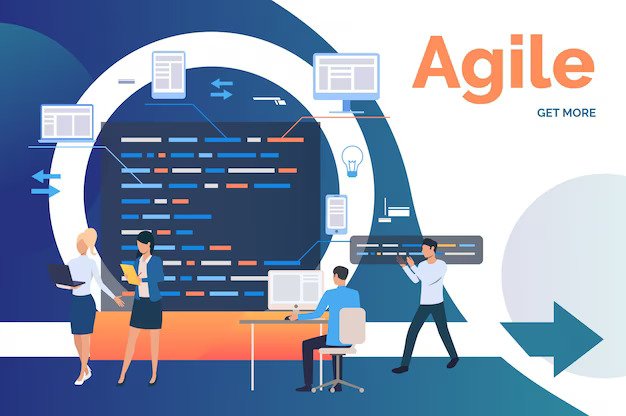
In today’s dynamic and fast-paced business landscape, staying ahead of the game is essential for success. As industries continue to be reshaped by technology, organizations must adapt and embrace innovative methodologies that foster efficiency, collaboration, and innovation. Enter Scaled Agile – a revolutionary approach that is rapidly gaining momentum across various sectors. In this blog post, we will explore the rise of Scaled Agile and why it is crucial for every business leader to understand its immense potential. Get ready to unlock the secrets behind this transformative methodology that promises unprecedented success for your organization! Demystifying Scaled Agile In recent years, the concept of Scaled Agile has garnered increasing interest. But what exactly is Scaled Agile? At its core, Scaled Agile is a methodology that enables organizations to successfully implement agile principles at scale. Clear communication and alignment across all levels of the organization, along with a focus on continuous improvement, are vital factors for the successful implementation of Scaled Agile. When executed correctly, it can enhance overall performance, efficiency, and cost-effectiveness for organizations. Moreover, it equips them with the agility to respond swiftly to market changes and customer demands. It is no surprise, then, that businesses of all sizes are embracing Scaled Agile. The Advantages of Scaled Agile Frameworks When it comes to software development, the Scaled Agile Framework (SAFe) has gained significant popularity. SAFe provides a set of guidelines and best practices for implementing agile methodologies within an enterprise. While traditional agile approaches like Scrum work well for small teams, they often struggle to scale up for large, complex projects. This is where SAFe shines. The benefits of using SAFe include: 1. Enhanced efficiency and productivity: By eliminating unnecessary steps and processes, SAFe enables teams to work more efficiently, resulting in increased productivity and faster delivery times. 2. Risk reduction: Following best practices for agile at scale reduces the risk of project failures within enterprises. 3. Improved quality: Applying SAFe throughout the software development process ensures the delivery of higher-quality products to customers. 4. Greater agility: SAFe empowers enterprises to be more agile in their approach to software development, enabling them to respond swiftly to market conditions and customer needs. 5. Better alignment: SAFe facilitates a common goal and alignment between teams, fostering improved communication and collaboration among team members. Providing Adequate Support for Teams Implementing Scaled Agile Practices To successfully implement scaled agile practices, it is crucial to provide teams with sufficient support. Establishing a robust and comprehensive support system is essential. This may involve offering training and development resources, as well as technical support staff to address any issues that arise. Creating a culture of collaboration and knowledge sharing is another vital aspect of ensuring teams have the necessary support during the implementation of scaled agile practices. By fostering an environment where team members feel comfortable sharing ideas and working together to solve problems, and ensuring information is easily accessible, organizations can empower their teams for success. Effective communication channels are also key to ensuring everyone understands what is happening and can provide feedback if needed. Formal channels, such as project management software, and informal channels, like team chat rooms or social media groups, contribute to a supportive environment for teams implementing scaled agile practices. Choosing the Right Model for Your Team’s Needs When it comes to scaled agile, there is no one-size-fits-all solution. The approach your team takes should align with the specific needs of your organization. Several models are available, each with its own advantages and disadvantages. The most critical consideration is selecting a model that suits your team’s needs. Here are a few popular options: 1. Scaled Agile Framework (SAFe): SAFe is a well-known scaling framework designed to help large organizations implement agile practices at scale. It integrates lean, product development flow, Kanban, and XP into a single framework. SAFe has been battle-tested in some of the world’s largest organizations, but it requires a significant commitment from all involved parties. 2. Large Scale Scrum (LeSS): LeSS is another popular scaling framework designed for large organizations. It integrates lean and XP into a simplified framework compared to SAFe. While LeSS may have fewer available resources than SAFe, its simplicity makes it easier to understand and implement. Real-World Examples of Successful Agile Transformations In the business world, success speaks for itself. Let’s explore some real-world examples of organizations that have achieved successful agile transformations: 1. ING Direct: By transitioning from a waterfall model to an agile one, ING Direct accelerated their time to market. This shift enabled them to introduce new features and products faster while increasing customer satisfaction. 2. Ford Motor Company: Ford adopted an agile development process for their SYNC 3 infotainment system and achieved impressive results. They delivered the system on time and within budget while improving quality and efficiency throughout the development process. 3. United Airlines: United Airlines embraced an agile development methodology and experienced significant improvements. Their website became more user-friendly, flights became more punctual, and overall customer satisfaction increased. These renowned organizations serve as inspiration for businesses aiming to transform their operations with agile methodologies. If they can do it, so can you! Key Considerations for a Smooth Transition When transitioning to Scaled Agile, several key factors must be considered. Firstly, ensure a clear understanding of your organization’s specific goals and objectives. Define the desired outcomes you aim to achieve through this transition. Secondly, gain buy-in and commitment from all levels within the organization. Top-down support is crucial for successful implementation. Lastly, establish well-defined processes and protocols to structure and distribute work across teams. These three pillars are essential for a smooth and successful transition. Common Pitfalls to Avoid While implementing scaled agile, it is important to avoid common pitfalls. Trying to do too much too soon is a common mistake. It is advisable to start small and gradually scale up the implementation. Another potential pitfall is not having the right people in place. Ensure that you have a strong team committed to the transition to scaled agile.
Scrum Alliance: Driving Agile Excellence and Fostering Collaboration

Introduction: In the fast-paced world of business, staying adaptable and nimble is crucial for success. Agile methodologies, particularly Scrum, have emerged as effective frameworks for managing projects in an iterative and collaborative manner. A key player in the agile landscape is the Scrum Alliance. This blog post delves into the significance of the Scrum Alliance in championing agile practices, facilitating knowledge transfer, and nurturing a strong community of agile practitioners. 1. Unleashing the Power of the Scrum Alliance Established in 2001, the Scrum Alliance is a non-profit organization that is committed to promoting and supporting Scrum’s principles and values. It serves as a global hub, connecting professionals, educators, and organizations seeking to embrace or enhance their agile practices. By offering an array of resources, certifications, events, and networking opportunities, the Scrum Alliance empowers individuals and teams throughout their agile journey. 2. Certifications for Agile Excellence A notable contribution of the Scrum Alliance lies in its comprehensive certification programs. These programs provide standardized training and recognition for individuals practicing Scrum. Popular certifications such as Certified ScrumMaster® (CSM®) and Certified Scrum Product Owner® (CSPO®) equip participants with essential knowledge, skills, and facilitation techniques necessary for effective leadership in Scrum teams. Moreover, the Scrum Alliance extends its certification offerings to advanced levels, including Certified Scrum Professional® (CSP®) and Certified Scrum Trainer® (CST®). These certifications enable agile professionals to elevate their expertise, contribute as mentors and trainers, and shape the future of the agile community. By obtaining these certifications, practitioners not only validate their skills but also demonstrate their commitment to continuous growth and professional development. 3. Collaborative Events and Engagements The Scrum Alliance actively promotes collaboration and knowledge sharing through a diverse range of events and engagements. The globally renowned Global Scrum Gathering® stands as a pinnacle event where agile practitioners from across the globe converge to learn, exchange experiences, and establish connections. With captivating keynote speeches, interactive workshops, and open spaces for discussion, participants gain insights from industry thought leaders and forge invaluable relationships. In addition to the flagship gathering, the Scrum Alliance extends its support to regional and local events, including user group meetings, meetups, and conferences. These events serve as platforms for agile enthusiasts to explore real-world case studies, learn from seasoned practitioners, and build robust networks within their local agile communities. 4. A Thriving Community of Agile Practitioners At its core, the Scrum Alliance thrives on the strength of its passionate and tightly-knit community of agile practitioners. Through online forums, discussion groups, and collaborative platforms, the alliance fosters an environment of knowledge exchange, problem-solving, and peer support. Members gain access to a vast network of professionals eager to share best practices, provide guidance, and facilitate growth. Furthermore, the Scrum Alliance nurtures a culture of mentorship and coaching within its community. Experienced agile professionals readily step forward as mentors, offering valuable guidance and support to those new to Scrum or seeking to refine their skills. This mentorship ethos not only strengthens individual capabilities but also fosters a sense of camaraderie and collaboration among agile practitioners. Conclusion The Scrum Alliance serves as a catalyst for the advancement and widespread adoption of Scrum principles and practices. Through its certification programs, collaborative events, and thriving community, the alliance empowers agile practitioners, supports their professional journeys, and fuels collaboration. By facilitating knowledge sharing and networking, the Scrum Alliance propels the growth of agile methodologies, empowering organizations to thrive amidst ever-evolving business landscapes. Whether you are an agile beginner or an experienced practitioner, joining the Scrum Alliance offers a gateway to an expansive network and a wealth of resources to guide and elevate your agile endeavors.
Agile Alliance: Driving Organizational Agility and Success

Introduction In today’s rapidly evolving business landscape, organizations across industries face the challenge of adapting to constant change. Traditional rigid methodologies no longer suffice, prompting the need for a more flexible and dynamic approach. Enter Agile Alliance, a global nonprofit organization at the forefront of advocating and advancing Agile practices. In this blog post, we will delve into the key concepts, benefits, and impact of Agile Alliance in driving organizational agility and success. What is Agile Alliance? Agile Alliance is a collaborative community of professionals dedicated to promoting Agile principles and practices worldwide. Founded in 2001, the organization serves as a platform for fostering knowledge sharing, providing resources, and facilitating dialogue among Agile enthusiasts, practitioners, and thought leaders. Agile Alliance aims to support individuals and organizations in adopting Agile methodologies to respond effectively to market dynamics and customer needs. The Core Principles of Agile At the heart of Agile Alliance’s mission lie the core principles of Agile methodology. Agile approaches emphasize iterative development, continuous feedback, and adaptability. Rather than following a linear project management approach, Agile embraces flexibility and collaboration. Key principles include valuing individuals and interactions over processes and tools, delivering working software frequently, fostering customer collaboration, and responding to change promptly. Promoting Collaboration and Knowledge Sharing Agile Alliance plays a vital role in fostering collaboration and knowledge sharing within the Agile community. The organization hosts the renowned Agile conference, a flagship event that brings together industry experts, practitioners, and newcomers to exchange ideas, share experiences, and learn from one another. Additionally, Agile Alliance publishes articles, whitepapers, and case studies, offering a wealth of resources to guide organizations in their Agile journey. Enabling Agile Education and Training To support the widespread adoption of Agile practices, Agile Alliance invests in education and training initiatives. The organization offers certification programs, workshops, and webinars to equip professionals with the necessary skills and knowledge to implement Agile methodologies successfully. By providing accessible and quality educational resources, Agile Alliance empowers individuals and teams to embrace Agile principles and achieve better outcomes. Driving Organizational Agility Agile Alliance plays a crucial role in driving organizational agility, enabling companies to respond swiftly to market changes, customer feedback, and emerging opportunities. By implementing Agile practices, organizations can improve project visibility, enhance collaboration, and deliver value incrementally. Agile methods such as Scrum and Kanban enable teams to adapt quickly, optimize productivity, and ensure continuous improvement, resulting in faster time-to-market and increased customer satisfaction. Benefits of Agile Adoption The benefits of Agile adoption are manifold. Agile methodologies promote transparency, reducing project risks and increasing stakeholder engagement. By fostering collaboration, Agile enables cross-functional teams to work together effectively, harnessing collective intelligence and creativity. Agile practices also encourage a customer-centric approach, ensuring that development efforts align closely with customer needs, resulting in higher-quality products and services. The Impact of Agile Alliance Over the years, Agile Alliance has had a significant impact on the software development industry and beyond. By advocating Agile principles and methodologies, the organization has sparked a global shift in mindset and approach to project management. Agile Alliance has played a crucial role in fostering innovation, enhancing product delivery processes, and improving overall organizational performance. Its efforts have contributed to the success of numerous companies and have influenced the evolution of Agile practices worldwide. Conclusion Agile Alliance continues to be a driving force behind the adoption and advancement of Agile methodologies. Through its collaborative community, educational initiatives, and knowledge sharing platforms, the organization empowers individuals and organizations to embrace Agile principles, driving organizational agility and success. In a rapidly changing world, Agile Alliance serves as a guiding light, helping businesses navigate uncertainty, enhance collaboration, and achieve better outcomes through Agile practices.
Agile Coaching: Empowering Teams for Success in a Dynamic World

Introduction: The realm of software development and project management is marked by rapid changes and constant evolution. In this landscape, Agile coaching have emerged as a game-changer, offering adaptive planning, evolutionary development, early delivery, and continuous improvement. Agile empowers teams to respond swiftly to customer needs and deliver top-quality products. However, Agile adoption requires more than a one-size-fits-all approach. It demands a transformative shift in mindset, culture, and work processes. This is where Agile coaching comes in – a vital role that guides organizations and teams on their Agile journey, fostering collaboration and nurturing high-performing teams. What is Agile Coaching? Agile coaching is a collaborative and iterative approach that facilitates the implementation of Agile principles and practices within an organization or team. An Agile coach acts as a mentor, facilitator, and catalyst for change, guiding teams through their Agile transformation journey. These professionals possess in-depth knowledge of Agile methodologies, diverse domain experience, and exceptional communication skills. Agile coaching is not about enforcing rigid rules; it’s about empowering teams to discover the best Agile practices that align with their unique challenges and objectives. The Role of an Agile Coach: Benefits of Agile Coaching: Conclusion: Agile methodologies have proven to be transformative in the world of software development. However, successful Agile adoption requires more than just following prescribed practices. It necessitates a cultural and mindset shift. Agile coaching plays a pivotal role in guiding organizations and teams through this transformational journey. By creating awareness, empowering teams, removing roadblocks, and fostering collaboration, Agile coaches enable the creation of high-performing teams that consistently deliver value. With their expertise and guidance, organizations can unlock the full potential of Agile and achieve sustainable success in today’s dynamic and competitive landscape.
How to Use DevOps and Scrum to Improve Software Delivery

Introduction : In the fast-paced world of software development, organizations are constantly seeking ways to enhance their software delivery process. Two popular methodologies that have gained significant attention are DevOps and Scrum. DevOps focuses on improving collaboration and integration between development and operations teams, while Scrum offers a framework for agile project management. Combining these two approaches can lead to more efficient and effective software delivery. In this blog post, we will explore how to leverage the power of DevOps and Scrum to optimize your software delivery process, resulting in improved productivity, quality, and customer satisfaction. Section 1: Understanding DevOps To begin, let’s delve into the concept of DevOps and its key principles. DevOps emphasizes the integration of development and operations, aiming to break down silos and create a culture of collaboration and shared responsibility. By promoting continuous integration, automated testing, and continuous delivery, DevOps fosters faster development cycles and ensures higher-quality software. Continuous integration allows developers to frequently merge their code changes into a central repository, enabling early detection of integration issues. Automated testing ensures that software changes are thoroughly tested, reducing the risk of defects and improving overall software quality. Continuous delivery allows for rapid and reliable software releases, enabling organizations to quickly respond to customer needs and market demands. Additionally, DevOps encourages the use of infrastructure as code (IaC) and deployment automation, enabling more consistent and reliable software releases. With IaC, infrastructure configurations are defined in code, making it easier to manage and replicate infrastructure environments. Section 2: Unveiling Scrum Now, let’s explore Scrum, an agile project management framework that helps teams deliver software iteratively and incrementally. Scrum operates through short, time-boxed iterations called sprints, during which teams plan, develop, test, and deliver valuable increments of the software. The Scrum framework comprises various roles, such as the Product Owner, Scrum Master, and Development Team, all working together to maximize transparency, inspection, and adaptation. Scrum provides a structured approach to managing software development projects, fostering flexibility, and enabling teams to quickly respond to changing requirements. Through the use of user stories, the Product Owner defines the desired functionalities from the user’s perspective. The Development Team collaborates to estimate, plan, and implement these user stories within the sprint. The Scrum Master ensures that the team adheres to the Scrum principles and facilitates the removal of any impediments that may hinder progress. Regular ceremonies, such as daily stand-up meetings, sprint planning, sprint reviews, and retrospectives, promote transparency, feedback, and continuous improvement. Section 3: Leveraging the Synergy When DevOps and Scrum are combined, their strengths complement each other, creating a powerful synergy that can revolutionize software delivery. Here are some key strategies for leveraging this synergy: 1. Collaboration and Communication: DevOps and Scrum both emphasize collaboration and effective communication. Encourage cross-functional teams to work closely together, facilitating seamless knowledge sharing and continuous feedback. Regular stand-up meetings, sprint reviews, and retrospectives promote transparency and foster a culture of continuous improvement. By bringing development, operations, and other stakeholders together, organizations can address issues and make informed decisions collaboratively. 2. Automation and Continuous Integration: DevOps encourages automation throughout the software development lifecycle, and Scrum emphasizes continuous integration. By automating processes such as code integration, testing, and deployment, you can ensure faster and more reliable software delivery. Tools like Jenkins, GitLab, and Docker can assist in automating these processes. Automated testing can be integrated into the CI/CD pipeline to provide quick feedback on the quality of software changes. This automation helps reduce errors, shorten feedback loops, and enables more frequent releases. 3. Infrastructure as Code (IaC): Adopting infrastructure as code practices allows you to manage your infrastructure through version-controlled code, enabling consistency and reproducibility. This aligns with DevOps principles and supports the iterative and incremental nature of Scrum. Infrastructure automation tools like Terraform and Ansible can be utilized to define and manage your infrastructure as code. By treating infrastructure configurations as code, organizations can ensure that infrastructure changes are tested, versioned, and deployed consistently alongside software changes, reducing the risk of configuration drift and improving overall system stability. 4. Continuous Improvement: Continuous improvement is at the heart of both DevOps and Scrum. Encourage regular retrospectives at the end of each sprint to reflect on what went well and identify areas for improvement. Use the insights gained from retrospectives to refine your processes, enhance collaboration, and optimize your software delivery pipeline. Consider implementing metrics and monitoring systems to gain visibility into the performance of your software delivery process. By measuring key metrics like lead time, deployment frequency, and mean time to recover, organizations can identify bottlenecks and continuously refine their practices. Conclusion: DevOps and Scrum offer complementary approaches to improving software delivery. By embracing DevOps principles such as collaboration, automation, and continuous integration, while leveraging the iterative and adaptive nature of Scrum, organizations can achieve faster, more reliable software releases. Remember to foster effective communication, automate processes, adopt infrastructure as code practices, and promote a culture of continuous improvement. By combining the strengths of DevOps and Scrum, you can transform your software delivery process, enhance productivity, deliver high-quality software, and increase customer satisfaction.
Unleashing the Power of Agile Metrics: Driving Success through Data-Driven Insights

Introduction In today’s fast-paced and competitive business world, organizations are constantly on the lookout for ways to optimize processes, boost productivity, and deliver exceptional value to customers. Agile metrics step up to the plate, providing essential insights into Agile team performance and progress. They empower organizations to make informed decisions, track project health, and foster continuous improvement. In this blog, we embark on a journey into the realm of Agile metrics, understanding their significance, exploring different types, and appreciating their pivotal role in driving successful Agile implementations. The Essence of Agile Metrics: Agile metrics act as guiding stars for organizations navigating the Agile landscape. They enable teams to measure and assess various aspects of their projects, unveiling bottlenecks, spotting opportunities for growth, and enabling data-driven decisions. By quantifying performance and progress, Agile metrics fuel teams to proactively tackle challenges, enhance collaboration, and optimize project outcomes. Exploring Agile Metric Types 1. Velocity: The velocity metric measures the amount of work an Agile team completes during a sprint. It provides crucial insights into team productivity and aids in predicting future performance using historical data. 2. Cycle Time: Cycle Time represents the duration taken to complete a user story, from inception to delivery. By tracking cycle time, teams can identify process inefficiencies, streamline workflows, and reduce lead times, resulting in faster deliveries and heightened customer satisfaction. 3. Burnup and Burndown Charts: These visual tools display the progress of work over time. Burnup charts showcase completed work against total planned or remaining work, managing scope and promoting effective communication within the team and stakeholders. 4. Defect Density: This metric measures the number of defects identified per unit of work, such as lines of code or user stories. Monitoring defect density empowers teams to gauge the quality of their deliverables, identify patterns, and implement preventive measures to minimize defects in future iterations. 5. Customer Satisfaction: Metrics like Net Promoter Score (NPS) or customer feedback ratings gauge customer satisfaction levels. Continuously monitoring customer satisfaction aligns Agile teams with customer needs, enables product feature enhancements, and cultivates customer loyalty. 6. Team Happiness: Happy teams are productive and collaborative teams. Metrics like team morale surveys or employee engagement scores offer insights into the team’s well-being, facilitating a positive work environment and nurturing team satisfaction. Driving Success through Agile Metrics Agile metrics are a catalyst for success in various ways. They foster transparency, granting stakeholders a clear understanding of project progress, risks, and opportunities. With this visibility, management can make informed decisions and adapt strategies as needed. Furthermore, Agile metrics fuel continuous improvement. By analyzing performance data, teams identify areas for improvement, implement process refinements, and strive for higher efficiency and productivity. Optimized sprint planning, reduced cycle time, and enhanced team collaboration become achievable goals. Lastly, Agile metrics promote accountability. Access to objective performance data motivates teams to take ownership of their work, pursue excellence, and honor their commitments. Conclusion Agile metrics hold the key to unlocking the full potential of Agile methodologies. By measuring various aspects of the Agile process, teams gain invaluable data-driven insights, paving the way for continuous improvement and project success. Whether it’s monitoring velocity, visualizing progress through burnup charts, or prioritizing customer satisfaction, Agile metrics serve as invaluable allies in the pursuit of excellence.
Unveiling Kanban: Empowering Agile Workflow Management

Introduction In the dynamic realm of modern business, organizations are perpetually in pursuit of efficient workflow management solutions. One such popular approach that has gained significant traction is Kanban. Initially developed by Toyota as a lean manufacturing method, Kanban has transformed into a versatile framework applicable across various industries. This blog post delves into the core principles of Kanban, its genesis, and how it can revolutionize the way teams handle their work processes. 1. Unearthing the Genesis and Essential Tenets of Kanban Kanban, derived from the Japanese terms for “visual signal” or “card,” was first introduced by Toyota in the 1940s as a scheduling system for manufacturing processes. Its purpose was to optimize production by minimizing waste and ensuring a seamless workflow. At the heart of Kanban lies the concept of visually representing work items using cards or signals. In the Kanban framework, each work item finds its manifestation on a Kanban board, typically comprised of columns representing distinct workflow stages. This visual aid enables teams to have a clear overview of their work, identify bottlenecks, and maintain a consistent flow of tasks. The work items are represented by cards that progress across the board, moving from one column to the next as they advance. 2. Key Principles Guiding Kanban Kanban operates on a set of fundamental principles: a) Visualizing the Workflow: The primary principle of Kanban is to visualize the workflow. By providing a transparent representation of the work process, teams gain insights into the status of each task, identify dependencies, and track progress effortlessly. b) Limiting Work in Progress (WIP): Kanban places great emphasis on limiting the number of ongoing work items at any given time. This constraint prevents overburdening and ensures that teams focus on completing tasks before commencing new ones. By minimizing multitasking, teams can enhance efficiency and reduce lead times. c) Managing Flow: Maintaining a smooth and continuous flow of work items lies at the core of Kanban. Teams strive to minimize waiting periods, overcome bottlenecks, and mitigate disruptions, thereby optimizing productivity and diminishing cycle times. d) Explicit Policies: Kanban encourages teams to establish explicit policies governing their work processes. These policies outline rules and guidelines for each stage of the workflow, fostering consistency and clarity among team members. 3. Benefits Unleashed by Kanban Organizations implementing Kanban can reap several benefits: a) Augmented Visibility: Kanban provides real-time visibility into the status of work items, enabling team members and stakeholders to track progress, identify obstacles, and make informed decisions effortlessly. b) Enhanced Efficiency: By imposing limits on work in progress, Kanban enables teams to concentrate on completing tasks instead of initiating new ones. This focus amplifies productivity, reduces context switching, and enhances overall efficiency. c) Increased Flexibility: Kanban exhibits remarkable adaptability, making it suitable for diverse industries and workflows. Its flexible nature empowers teams to tailor the framework to their specific needs, rendering it viable for both small teams and large organizations. d) Continuous Improvement: Kanban fosters a culture of continuous improvement. By regularly scrutinizing the flow of work, teams can identify areas for optimization, experiment with process alterations, and continually refine their workflows. Conclusion Kanban offers a potent framework for managing workflows in a visual, efficient, and adaptable manner. By visualizing work, limiting work in progress, managing flow, and establishing explicit policies, teams can streamline their processes and achieve elevated levels of productivity. Whether in software development, project management, or any other industry, Kanban empowers organizations to optimize their workflows, minimize waste, and deliver value to customers with greater efficacy. Embracing Kanban marks a pivotal step toward adopting an agile and responsive approach to work, enabling teams to thrive in today’s ever-evolving business landscape.
Choosing the Right Path: Comparing Waterfall and Agile Product Development

Introduction In the world of software development, there are two main project management methodologies: waterfall and agile. Both methodologies have their own strengths and weaknesses, and the best approach for a particular project will depend on a number of factors, such as the size and complexity of the project, the level of uncertainty involved, and the needs of the stakeholders. Waterfall Methodology The waterfall methodology is a linear, sequential approach to project management. Each phase of the project must be completed before the next phase can begin. This approach is well-suited for projects where the requirements are well-defined and there is little uncertainty. The waterfall methodology can be broken down into the following phases: Agile Methodology The agile methodology is an iterative, incremental approach to project management. The project is broken down into small, manageable chunks, and each chunk is developed and delivered in a short sprint. This approach is well-suited for projects where the requirements are not well-defined or where there is a high level of uncertainty. The agile methodology can be broken down into the following phases: Comparison of Waterfall and Agile The following table compares the waterfall and agile methodologies on a number of dimensions: Dimension Waterfall Agile Planning Extensive upfront planning Less planning, more focus on iteration and adaptation Communication Communication is primarily between stakeholders and project manager Communication is more fluid and occurs throughout the project Risk management Risks are identified and managed early in the project Risks are identified and managed throughout the project Change management Changes are difficult to make once the project has started Changes are easier to make because the project is broken down into smaller chunks Documentation Extensive documentation is created Less documentation is created Testing Testing is done at the end of the project Testing is done throughout the project Deployment Deployment is done at the end of the project Deployment can happen multiple times throughout the project Which Methodology is Right for You? The best approach for a particular project will depend on a number of factors, such as the size and complexity of the project, the level of uncertainty involved, and the needs of the stakeholders. If the project is large and complex, with well-defined requirements, then the waterfall methodology may be a good fit. If the project is small and simple, with less well-defined requirements, then the agile methodology may be a better fit. Ultimately, the best way to decide which methodology is right for you is to consider the specific needs of your project. Conclusion The waterfall and agile methodologies are two of the most popular project management methodologies in software development. Both methodologies have their own strengths and weaknesses, and the best approach for a particular project will depend on a number of factors.

